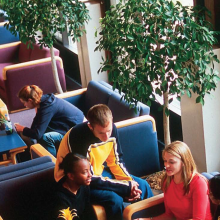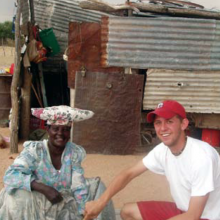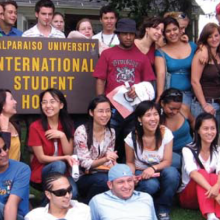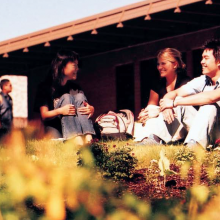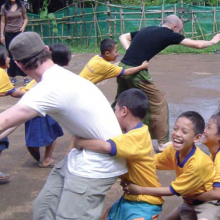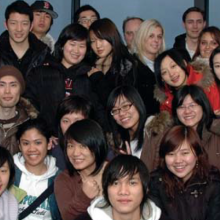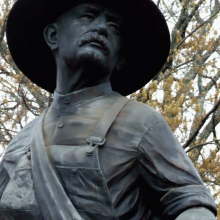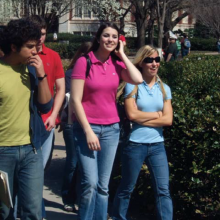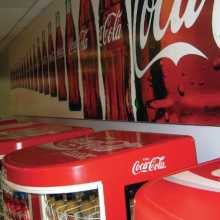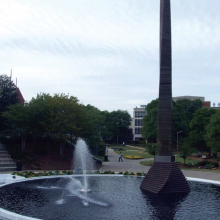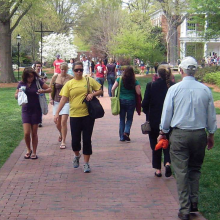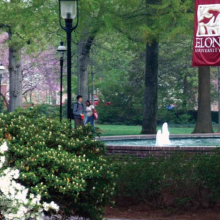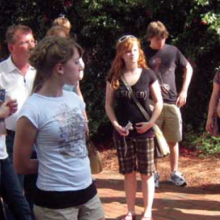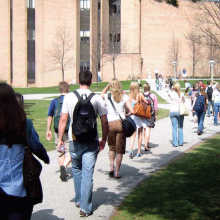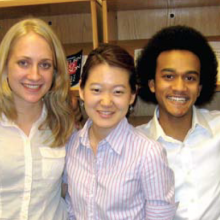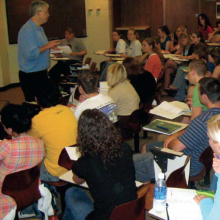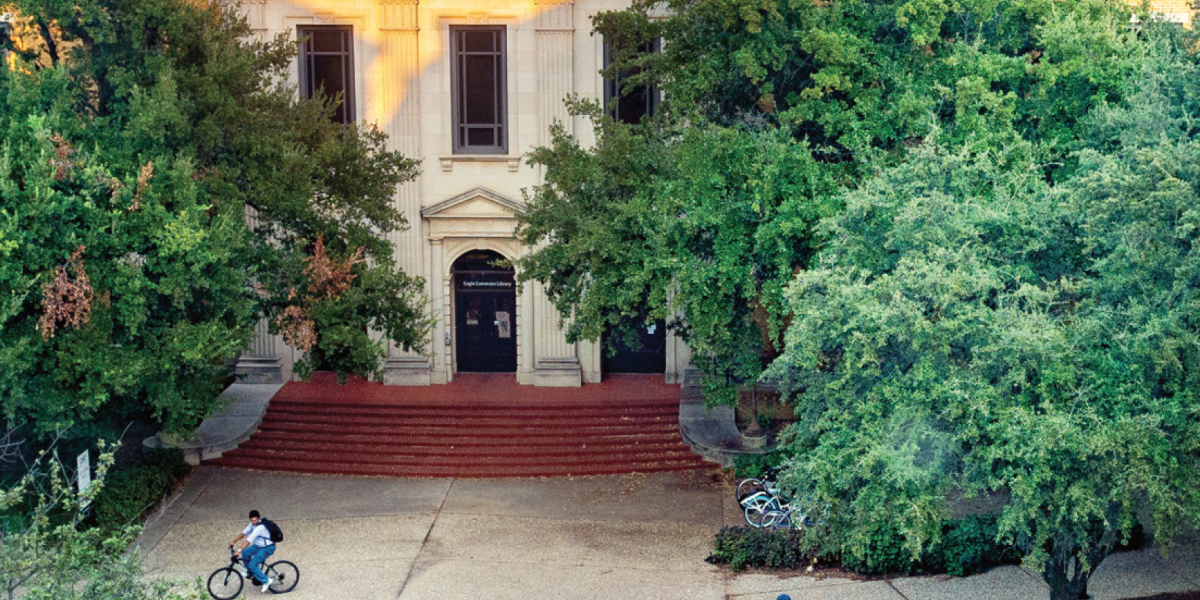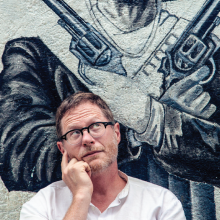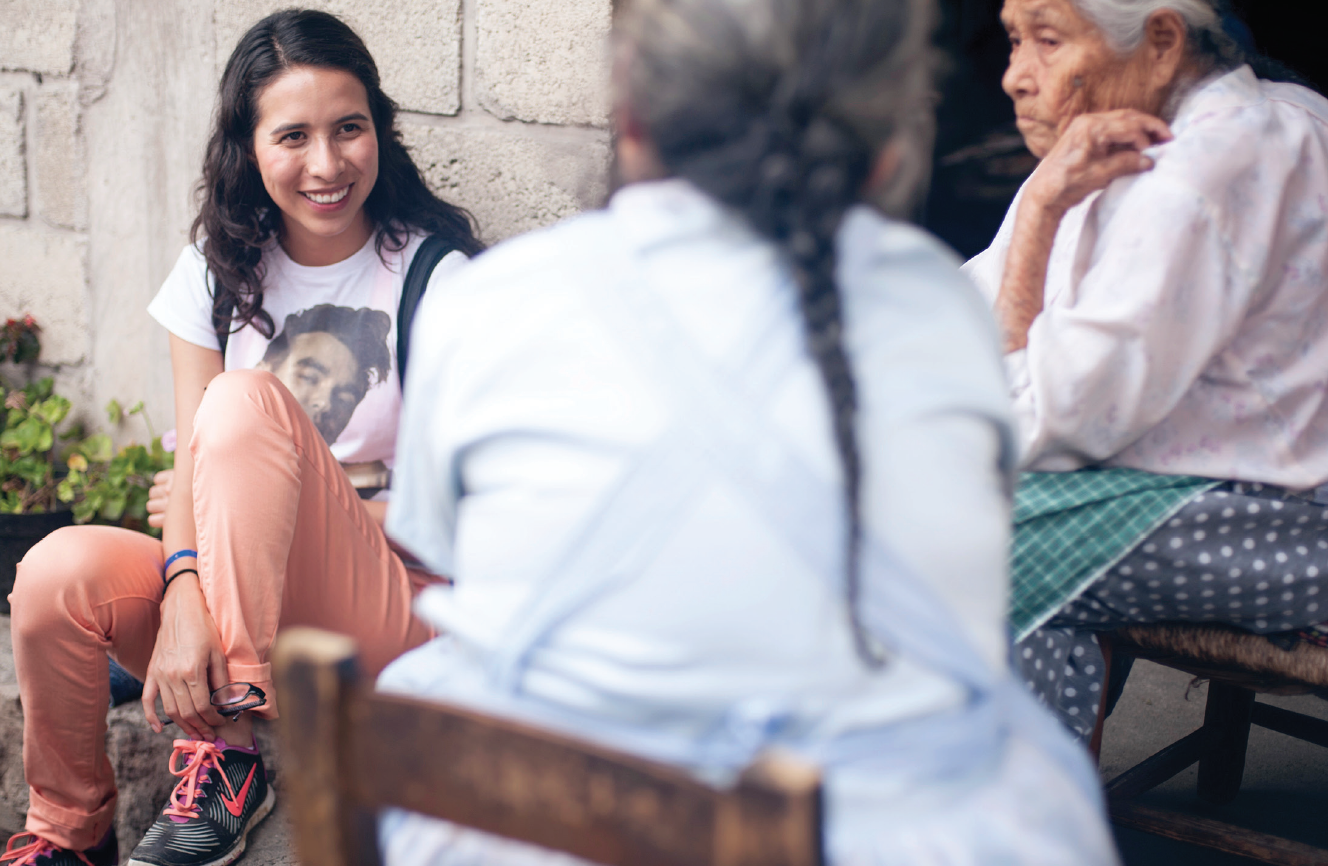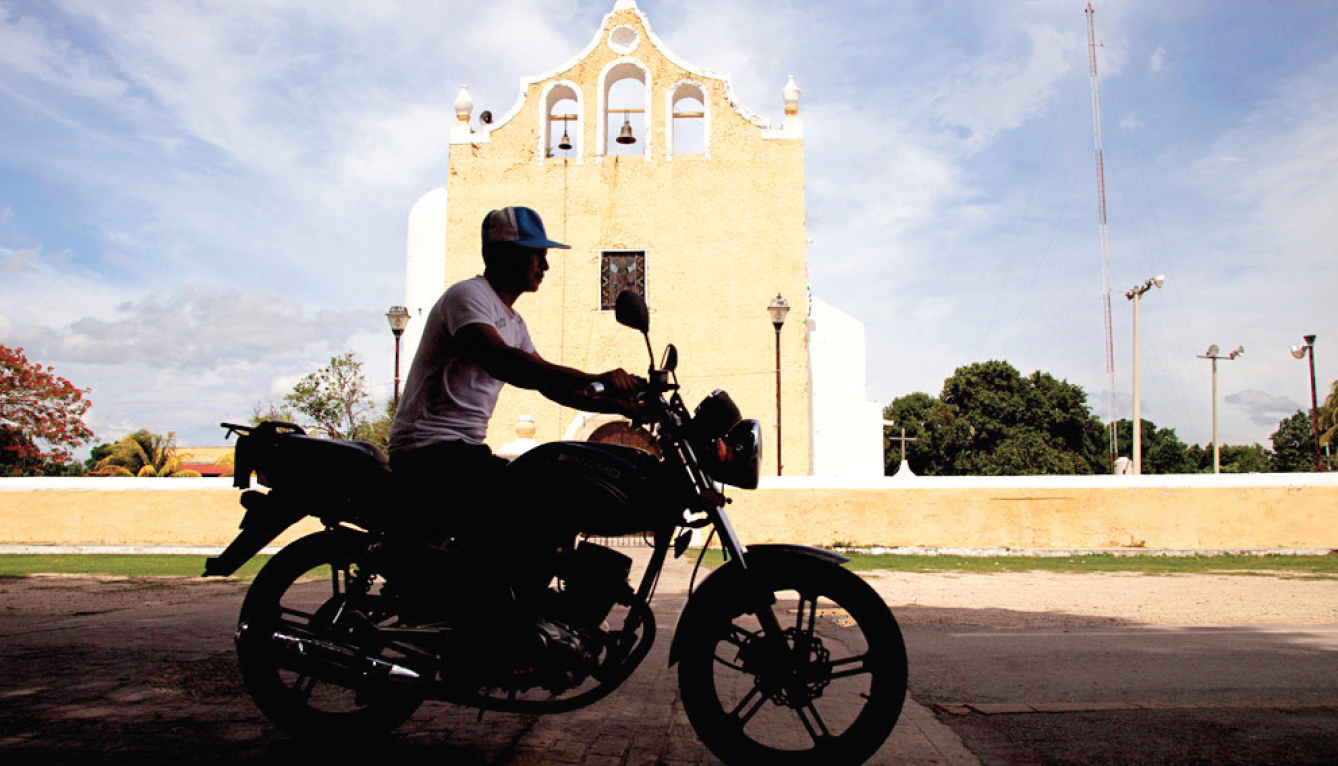Internationalization
2020: Innovation as the New Global Education
Talking Points: Defending F-1 Optional Practical Training
2007 Spotlight Valparaiso University
There is no ice hockey team at basket-ball-crazed Valparaiso University, but the Indiana institution completed a hat trick this spring when for the third time in four years a trio of seniors was awarded Fulbright scholarships. They are bound for China, South Korea, and Germany. For a campus with 3,000 undergraduates, it was evidence how successful the 148-year-old independent Lutheran school has been in infusing the curriculum with international content and encouraging students to explore global issues. Valparaiso sends upwards of 200 students a year to study abroad, many to programs it operates in Cambridge, England; Reutlingen, Germany; Puebla, Mexico; and Hangzhou, China. It requires nearly all freshmen—including nearly 1,000 business, engineering, and nursing majors—to take a two-semester, interdisciplinary course that meets five hours a week to discuss texts from the East Asia and Afghanistan, from Plato and Sophocles, and from the Old and New Testaments of the Bible (the 80 freshman in the honors program, Christ College, read equally diverse and global texts).
One of the latest Fulbrighters, Carl Boschert, a Chinese and Japanese studies and history major from Jackson, Mississippi, spent a semester at Valparaiso’s Hangzhou Study Center and made two other research trips to China. Associate professor of history Charles Schaefer, who advises the Fulbright applicants, sees “a direct correlation between our students’ performance in winning Fulbright awards and our overseas study programs. Many of our students have studied overseas for a semester or an entire year and come back with an expanded world view and an interest in exploring international studies even further.” Schaefer himself as a Fulbright lecturer at Addis Ababa University in the 1990s.
Religious and classical music occupy an important place in the life of Valparaiso. A $1.5 million gift allowed it to open a Bach Institute in 2003, and the university chorale has toured Germany twice in recent years and performed as a resident choir in Leipzig at St. Thomas Church, where Johann Sebastian Bach was cantor for the last 27 years of his life and where he is buried.
The Valpo Core Course Leads Internationalization
“We provide a lot of opportunity within a small-size liberal arts college,” says Provost Roy Austensen. “We provide a liberal arts education for engineers and accountants and finance majors and nurses as well” as arts and science majors (Valparaiso’s law school, which dates back to 1879, enrolls 500 students; 400 other graduate students pursue degrees in arts and sciences, business and nursing). John R. Ruff, associate professor of English and director of the Valpo Core Course, describes it this way:
Since its inception in 1998 the Valpo Core has helped to broaden and internationalize Valparaiso University first-year students’ horizons. Almost every unit in this year-long course puts into dialogue texts from different eras and traditions: Gilgamesh with Genesis , Shusako Endo’s Silence with the Gospel of Mark, Lord Shang and Mencius with Plato and John Stuart Mill, The Bhagavad Gita with Martin Luther’s Christian Liberty . Laura Esquival’s Like Water for Chocolate transported us to Mexico during the Mexican Revolution; Julia Alvarez’s In the Time of the Butterflies took us to the Dominican Republic during the Trujillo era; Philip Gourevitch’s We Wish to Inform You That Tomorrow We Will Be Killed With Our Families brought us to Rwanda after the genocide. Khaled Hosseini’s The Kite Runner , set mostly in Afghanistan, has been one of our most successful texts; Il Postino and Cinema Paradiso , set in Italy, are among our most successful films. This past year Sonia Nazario’s Enrique’s Journey helped us put a human face on the undocumented worker traveling by train from Honduras into the United States, a harrowing and heartbreaking tale.
Gourevitch and Nazario have spoken on campus, and Elias Chacour, the Palestinian peace activist and priest whose autobiography Blood Brother was just added to the syllabus, has been invited.
Valparaiso draws a third of its students from Indiana and almost as many from Illinois and elsewhere in the Midwest. The campus is located an hour outside Chicago and 15 miles south of Lake Michigan and the 15,000-acre Indiana Dunes National Lakeshore. International students numbered 118 in 2006. With a 13-to-1 ratio of students to faculty, Valparaiso prides itself on keeping classes small. To keep each of the 40 sections of the Valpo Core Course under 20 students, the university encourages every department except engineering to contribute faculty, and most do. “The beauty is that the core stimulates a conversation about major ideas and themes in human history among a wide variety of faculty members, some of whom haven’t touched texts like these since they were undergraduates themselves—if then,” says Austensen, whose field is modern European history. “It enlivens the intellectual climate of the campus.”
Before the Valpo Core, there was a required freshman seminar, but the topics and syllabi varied widely. Jon T. Kilpinen, dean of the College of Arts and Sciences, says, “As a residential campus, we felt that building a common experience among the freshmen was important. It would assist with retention but also help build a sense of community and identity for each group of students.” The Valpo Core looks at themes of life, death, vocation, loss, and love through the lens of great works of literature and art. Many texts are ancient classics, but others explore modern dilemmas, such as Tracy Kidder’s gripping Mountains Beyond Mountains on Dr. Paul Farmer’s fight against poverty and infectious diseases in Haiti and globally.
Associate Provost Renu Juneja, who joined the faculty in 1978 after coming to the United States from India on a Fulbright scholarship, said teachers from different fields come together as cohorts to discuss the texts before teaching them to the students. “What has developed is a mathematician sitting with a nurse sitting with a historian sitting with an English professor sitting with a chemist, and the conversation that takes place among these people before they even go to teach has in some ways transformed the experience for our students,” says Juneja, a professor of English.
Hugh E. McGuigan, director of International Studies, is convinced the freshman Core whets student appetites for study abroad. Valparaiso is a founding member of the Associated New American Colleges (ANAC), formed in 1994 by a group of mid-sized, comprehensive universities that emphasize undergraduate education and offer master’s and professional degrees. Elon University, a 2007 winner of the Senator Paul Simon Award for Campus Internationalization, also belongs to the group of 22 institutions, which allows members to send students on each other’s study abroad programs at no additional cost. “We’ve got a student now studying in Morocco through Mercer University, and we had two in the fall through Butler’s program in Alcalá, Spain. We have another student in Puebla, Mexico, through Ithaca College. This ANAC consortium is giving us more study abroad opportunities in countries where we don’t have our own programs,” says McGuigan, who has been at Valparaiso since 1983.
The Fifth Hour—A Movable Feast
The most unusual feature of the 10-credit Valpo Core is the fifth hour each week that takes place outside the classroom. “In some ways it’s a moveable feast. A variety of activities take up that fifth hour. The residential life people on campus have become very involved with the Core,” says Dean Kilpinen. “Since our freshmen live together, the student affairs people do programming in the residence halls that matches the syllabus. Likewise, our art museum also follows the syllabus.” The museum displays works of art that relate to the topics under discussion in a special room.
The activities and the undertakings vary, and not everybody must do the same thing. “If there’s a German film festival on campus, that could be a core-approved activity, or a jazz festival, or our Martin Luther King Day celebration,” says Juneja. Students must write about their activities—the Valpo Core is a writing-intensive experience—but no one scans IDs at the door.
Mel W. Piehl, professor of humanities and history and dean of Christ College, notes the honors college has incorporated classic Chinese and Japanese texts and East Asian issues into its freshman curriculum. “Students regularly read Mencius, Chuang-Tzu, Hsun-Tzu, Lu Xun, and other classical and contemporary Chinese thinkers,” says Piehl, a 1968 alumnus. And the college provides “Albert Schweitzer Fellowships” for students to work as medical volunteers in mobile clinics in Costa Rican and Nicaraguan villages over Valparaiso’s two-week spring break.
Sending New Faculty Abroad
Valparaiso also sends new faculty after their first year off to Cambridge, England, for a week-long retreat. They live in apartments that Valparaiso students occupy in the fall and spring, see shows on London’s West End and visit the usual sights, but they also learn firsthand just how much importance Valparaiso places on international education. “Part is acculturating them to the special mission of this university and part is helping them bond with each other as a cohort so they are not in their silos. But part is also to widen their horizons,” says Juneja. “However much we say that England is like America, it’s really another strange country for most Americans.” In summer 2006, the entire Christ College faculty traveled to Berlin, Leipzig, Wittenberg, and Erfurt, Germany, for 10 days; other faculty have traveled as a group to China.
International Presence on Campus
When Juneja and her husband, political scientist James L. Kingsland, joined the faculty in 1978, she found herself one of the few international professors on campus and one of only a handful of people from India in the community. Now, almost two dozen of Valparaiso’s 254 full-time faculty is international. “It’s changed so much,” she says. “I remember when there were only four or five Indian families in the surrounding area, and now we can’t find a hall to accommodate us all. We built a cultural center 15 miles from here and this is happening in other communities as well. I am a Sikh and we built our own temple. I just find the whole situation has changed dramatically.”
International enrollments actually peaked in the late 1990s before Asian enrollments dropped after a currency crisis, and fewer students from the Middle East came after the September 11, 2001, attacks on the United States. “But the trend now is going back up,” says McGuigan, especially with the government of Saudi Arabia funding scholarships for its nationals to study in the United States.
“We are going about this much more deliberately,” says Juneja. “When I came there was no concerted effort made to recruit students internationally. It was personal contacts and church connections that brought us students. It’s only in the last 15 years that we’ve actually done international recruiting.” At first Valparaiso was content to send a representative on tours to college fairs in Asia, the Middle East, and Latin America. Now it is lining up exchanges with partner universities in China and elsewhere. Holly Singh, assistant director of international programs, also has made several recruiting trips to India, his homeland.
“We have partnerships now with five Chinese universities. They send us students … and we host their faculty for professional development. Many Chinese faculty have come here for a semester,” says Juneja. Almost five dozen professors from Zhejiang University in Hangzhou—where VU’s own study center is located—and other universities in China have been visiting scholars at Valparaiso. Using its religious connections, Valparaiso also hosts young faculty from overseas who are sent to the Indiana campus for four months of mentoring by the United Board for Christian Higher Education in Asia. Eighteen professors early in their careers have made that journey over the past four years from institutions in China, India, the Philippines, Taiwan, Thailand, Cambodia, Vietnam, and Indonesia. McGuigan said that one participant, a professor of English from Nanjing University, “just fell in love with Valpo” and immediately recruited four students to come to Valparaiso for master’s degrees in international commerce and policy, as well as English and communications.
A former president, O.P. Kretzmann, once defined religious universities such as Valparaiso as places “where Athens and Jerusalem meet.” Nowadays, Valparaiso is adding other cities across Europe, Asia, and Latin America to that mix, and Valpo’s students are the better for it.
Valparaiso University
2007 Spotlight Shoreline Community College
When Shoreline Community College was built in a Seattle suburb 10 miles from the Space Needle in 1964, the wooded, 83-acre campus was designed to look like a Japanese botanical garden. The student union, the PUB, was an acronym for Pagoda Union Building, and until the 1990s its sports teams competed as the Shoreline Samurai. That nickname was abandoned after student leaders decided it was demeaning, and today Shoreline athletes take the field as the Dolphins.
But Shoreline itself is more international than ever, with a record 643 international students enrolled in 2006-07 and scores of students along with faculty studying overseas each summer. Many of these ambitious programs were spawned by an initiative the college took in 2001 when it created an International Programs Advisory Committee (IPAC) with an annual purse of $20,000 to disburse grants to faculty to develop short-term study and service abroad projects. That next summer, faculty led dozens of students on three-week study trips to Antigua, Guatemala; Monterrey, Mexico; and London, England. Every summer since then, 45 to 70 Shoreline students have headed off to earn credit in China, Japan, Ireland, Greece, Turkey, Namibia, South Africa, Thailand, Honduras, Peru, Argentina, Iceland, and elsewhere.
Through Shoreline’s membership in the Washington Community College Consortium for Study Abroad, students also can take classes during the fall, winter, and spring in London, Florence, Paris, Salamanca, and San Jose, Costa Rica. From 1999 through 2006, 120 Shoreline students studied abroad through the consortium, and three Shoreline professors taught classes overseas.
In a region replete with excellent community colleges, Shoreline must scramble for students, despite its excellent track record in sending graduates to the University of Washington for four-year degrees. The commuter college, two miles inland from Puget Sound, is the tenth largest of Washington’s 34 community colleges. In addition to awarding associate degrees in arts and sciences, it prepares students for careers in health, technology, and computers and has an award-winning automotive training center. Most of the international students who make their way to Shoreline seek to transfer to universities, says Thalia Saplad, executive director of the Office of International Programs. “For international students, business is number 1. Our engineering, health occupation, and nursing programs are also draws, as well as biotechnology.” Many international students come from Asia, with the largest numbers from Indonesia, Hong Kong, Korea, and Japan.
After two presidents departed in four years, Shoreline found stability when civil rights attorney Lee D. Lambert was promoted in 2005 to interim president and later given the job on a permanent basis. Through it all, support from the top for Shoreline’s internationalization was unwavering. The commuter campus earmarked $85,000 in 2005–06 and another $85,000 in 2006–07 toward internationalization projects, including grants for faculty development, study abroad scholarships as well as improved services for international students. “The administration is very supportive of building programs and curricula that prepare our students to be global citizens,” says Saplad.
Praise from Accreditors
The Northwest Association of Schools and Colleges and Universities commended Shoreline in 2002 for “its excellent international studies program.” The visitors left “impressed by the exemplary and creative efforts to recruit and accommodate international students and to use resources from the success of that program to encourage faculty and students to travel and study abroad.”
A 10-person staff works on international programs and advises the growing ranks of students from around the world. “We’ve made a concerted effort in the past several years to integrate our international education programs and our international students with the rest of the campus,” says Saplad. “More and more international students have taken leadership positions in our student government. They hold eight of the 12 executive offices this year.”
International Peer Mentors
Mari Kosin, assistant director of international student services, laid the groundwork for the emergence of international students into leadership positions with a program she started five years ago called International Peer Mentors (IPM). Five students are selected annually for these paid positions, in which mentors help newcomers to the United States adjust to life at Shoreline and in the Seattle area. The mentors take diversity training alongside full-time college staff and help shape both educational and extracurricular activities for their peers.
“They play a major role in our orientation for international students,” says Saplad. “They’ve helped get more international students to partake in activities and to get more involved in their education. They undergo professional development with my staff and we send them to conferences around the state. It’s the first time in years where international students have really seen themselves as part of the institution.”
Colleen Ferguson, assistant director of international education, said the first international students to run for campus-wide office were veterans of the International Peer Mentors program. “They learned a lot about the institution and how it worked. They had the confidence to apply for posts in student government because they had held these IPM leadership jobs for a year,” she says.
An Exploration of Irish Literature and Culture
The International Programs Advisory Committee, which includes two Shoreline students, two staff members, and a broad representation of faculty, sifts through faculty proposals for summer study abroad courses and decides which ones to fund. Gary A. Parks, a professor of English literature and creative writing, received a green light from IPAC to take creative writing students to Ireland in August 2006 to explore the sources of inspiration for W.B. Yeats, James Joyce, and other authors and to craft stories of their own. In addition to viewing the Book of Kells in Trinity College in Dublin and standing before the majestic Cliffs of Moher jutting into the Atlantic off County Clare, they attended a poetry slam at a pub in Galway and worked up sketches about life in nineteenth century, famine-stricken Ireland while visiting Inishmore, birthplace of novelist and activist Liam O’Flaherty.
“The driving query of the class was that I wanted people to explore the question of why such a small nation has produced so much great literature,” says Parks, who has taught at Shoreline for 16 years. Six men and two women, all 21 or younger, signed up for the course, which cost $2,400 plus $600 for meals. Given a choice of taking an introduction to Irish literature or a short story writing class, all opted for the latter, “which simplified things for me and made it a bit more fun,” he says.
He had students read excerpts from Mackin’s 1955 novel, Rain on the Wind. “We did the Yeats pilgrimage to Sligo, and visited Inishmore, an island in the Gaeltacht off the west coast of Ireland,” he says. “A lot of native speakers there still speak Irish. Liam Flaherty’s stories get mystical in places, and when you read them on Inishmore you can really understand how this place would give rise to these stories.”
“It was a great experience,” says Parks. When the students came home, half signed up for an Irish literature course that he inaugurated at Shoreline that fall. “That class filled up with 27 students. It was a nice follow-up in terms of internationalizing the campus,” he says.
Service Learning in Jamaica
One of the most frequent fliers on Shoreline’s faculty is psychology professor Robert B. Thompson, who regularly leads students on a 16-day summer service learning trip to the Blue Mountains of Jamaica, where they volunteer in the schools of a rustic village. Thompson worked as a psychologist alongside the Peace Corps in that same village two decades ago and has returned with students ever since, first while teaching at Rollins College and over the past 13 years at Shoreline.
“It’s a village without electricity only 25 miles from downtown Kingston, but very difficult to get to. We have to go up the mountain by four-wheel-drive truck,” he says. “The students live at the houses of two coffee farmers and work within the community, primarily tutoring in two elementary schools.” Thompson twice has spent six-month sabbaticals in the Blue Mountains and returned to campus in 2006 determined to help the Jamaican farmers secure a niche and better prices in Seattle’s food markets for their rich coffee beans.
“I recruit the students out of my psychology classes,” says Thompson. “They are very diverse. On this summer’s trip, 75 percent have never before traveled outside the Northwest. It’s a unique opportunity for them. I have three students over age 50, several in their 30s and 40s, and students who are 18, 19 years of age.”
Both Thompson and the students find the readjustment upon return to Seattle challenging. “You’re bombarded with the technologies, the lights, noises. Everybody’s in a hurry. Once you get accustomed to a certain rhythm, it’s very difficult to come back and be thrown into another culture,” he says. “The students see their culture and their surroundings in a different way.” Some, he adds, change career paths so they can deal directly with the poverty they saw in the Blue Mountains.
A Commitment to Multicultural and Global Awareness
Thompson, who served on the IPAC for four years, says Shoreline “definitely is an unusual community college. A lot of four-year schools don’t support the type of unique (study abroad and international service) programs we have.”
Parks said the emphasis on the international at Shoreline fits in with its “tradition of being a strong academic transfer school. It’s just part of our history and culture here. We have a commitment to multicultural awareness and global awareness.”
Shoreline’s summer study abroad programs are open to all students and members of the community, although traditionally they have drawn primarily those on track to transfer to a four-year institution. The Office of International Programs now is stepping up efforts to interest more of the students who are seeking technical and professional degrees in study abroad. Two new exchange partnerships have already borne fruit. Last winter, six Danish business students from Erhvervs Akademi Vest (Business Academy West) in Esbjerg, Denmark, came to Shoreline for classes and internships with local businesses, and Shoreline and the Danish institute exchanged business and marketing professors for two weeks. Shoreline has won awards for its automotive technology offerings and this past summer 20 students from Ajou Motor College in Boryeong, South Korea, spent two weeks at Shoreline to kick off a reciprocal student exchange program. Ajou’s program is regarded as one of the finest in its country.
President Lambert, who is Korean-American, summed it up last fall in his first “State of the College” address. “One of the great challenges before us is how we prepare our students, community, and workforce to compete in a global world,” Lambert said. Stressing the importance of the liberal arts to the development of the whole person, he added, “Whether it’s the nineteenth century or the twenty-first century, there are certain skills and talents that are universal from one generation to the next. I am proud to be part of a campus that grapples with these issues as we debate ways to ensure that all of our students receive a world-class educational experience.”
Shoreline Community College
2007 Comprehensive University of Oklahoma
A stranger visiting the University of Oklahoma’s graceful campus in Norman, Oklahoma, who drives down David L. Boren Boulevard, or strolls into the David L. Boren Honors College, or spies the statue of David Boren in a cornice on Evans Hall might assume that Boren led the university during its glory days.
He did—and still does. For the University of Oklahoma, these past 13 years since David L. Boren relinquished a powerful seat in the U.S. Senate to lead his alma mater are the glory days. In writing a new chapter in a life of public service, Boren has presided over a period of dramatic growth and growing confidence for the University of Oklahoma. Sooners have always taken kindly to Boren, the former Rhodes Scholar and politician. They elected him governor at age 33 in a near landslide in 1974, and he won his last Senate race in 1990 with 83 percent of the vote. On his watch OU has quadrupled the number of endowed professor chairs, raised more than $1 billion, and erected dozens of new academic facilities. Even the powerful football team has added a seventh national championship to its trophy case. (A predecessor, George Lynn Cross, once quipped that he wanted to build a university of which the football team could be proud.)
Befitting a former chair of the Senate Select Committee on Intelligence and a man for whom a federal study abroad scholarship is named, Boren has given international education pride of place in OU’s curriculum and activities and made the Norman campus a regular stop for world leaders from Margaret Thatcher to Mikhail Gorbachev. Soon after taking office in 2006 as Africa’s first elected female head of state, Liberia’s President Ellen Johnson-Sirleaf visited at the invitation of Boren and Ambassador Edward J. Perkins, OU’s senior vice provost for international programs and former U.S. ambassador to Liberia, South Africa, and Australia.
Spurt in International Studies
Oklahoma has boosted study abroad by providing $250,000 in international travel grants and fellowships for students and faculty; three-quarters goes to students. OU has added 15 faculty positions in Chinese and Arabic languages, Asian philosophy, history and politics, the economics of development, European security and integration, international business management, and other disciplines. The School of International and Area Studies, launched in 2001, has grown from three dozen to 350 majors. “It is a hard-charging group,” said political scientist Robert H. Cox, the founding director. “We require them to study abroad for at least a semester and take at least two years of a language.” Suzette Grillot, an associate professor of political science, says the myriad of international events held on the Norman campus “gets students energized. They learn something about the world here, and that energizes them to go out and actually see that part of the world or study the issue.” Perkins, who was ambassador to South Africa during the final tumultuous years of apartheid, says, “When we first started this, we heard from some professors, ‘Don’t be ridiculous. Anybody who wants to study international relations is going to go to some place back East to study.’ Well that’s not true at all.”
Of the 23,000 students enrolled on the Norman campus, 1,551 are international students. Oklahoma has forged exchange agreements with 173 partner universities in 60 countries and each year hosts approximately 750 visiting students while sending an equal number off to study at those institutions. Millie C. Audas, director of Education Abroad and International Student Services, notes that in addition to enriching the education of thousands of students, the exchanges also have produced at least 89 marriages. The ebullient Audas, a Bolivian-born former language professor with an OU doctorate in higher education administration, received a second doctorate in honoris causa from Université Blaise Pascal in Clermont-Ferrand, France—OU’s oldest partner—in 2005 for building Oklahoma’s exchange enterprise over nearly three decades. “I was honored not for any research, not for any academic advancement, but for the human relations and the human attachments between the people of France and the people of the United States. That was glorious for me,” said Audas, whose husband, William Audas, is a retired OU director of career services and founding director of the J.C. Penney Leadership Center at Price College of Business, in which numerous international students participate.
Audas first came to Norman as a language instructor in 1978. When she became the first full-time director of Education Abroad and International Student Services in 1986, she quickly found kindred spirits across the faculty, including cell biologist Paul B. Bell, Jr., who had done extensive research in Sweden and shared her enthusiasm for study abroad and partnering with institutions overseas. “By having all these exchanges, we have significantly increased the diversity of international students at OU,” says Bell, now vice provost for instruction and dean of the College of Arts and Sciences. Audas still travels the world to oversee existing exchanges and strike new compacts. “It’s labor intensive to make all these collaborations and agreements live. They are not just on paper. But we’ve had incredible momentum, rhetoric, and funding from President Boren,” she says.
Boren’s Days At Balliol
President Boren recalls with a smile that on his first visit to campus as president-elect, “Millie Audas intercepted me on the sidewalk and said, ‘Can I walk with you? I’ve been waiting all my career for someone like you to become president of OU.” Boren immediately proclaimed her his “soul mate.” Boren needed no convincing about international education. A congressman’s son, he was elected president of the Yale Political Union and won a Rhodes Scholarship to Oxford after graduation in 1963. He was at Balliol College when word came that President John F. Kennedy had been shot; he was still there 14 months later when Britain bade farewell to its great wartime leader, Winston Churchill. “I learned so much about my own country by being outside it,” says Boren.
During Oxford’s long reading periods, he trekked to more than 30 countries across Europe and the Middle East. Boren also volunteered with the speaker’s bureau at the U.S. Embassy in London, speaking before ladies’ garden clubs in little towns across England. It left him convinced of the importance of being a good listener and seeing the world through others’ eyes. Boren believes it crucial for OU students to explore the world beyond the Red River. “Oklahoma is in the middle of the country. We have one of the lowest percentages of any states of first-generation Americans and the highest percentage of people born in this country,” he says.
OU Cousins
Soon after their arrival, Boren and wife Molly Shi Boren, a former teacher and judge, got into a conversation with a student from Malaysia who helped cater an event at the president’s house. “I said to him, ‘How many American students have you gotten to know really well while you’ve been here?’ and he said, ‘Not very many. We international students tend to stay together,’” Boren recalls. The young man expressed regret that he had not gotten to visit an American farm nor seen any “real cowboys.” The Borens’ offer to escort him to a friend’s ranch came too late; he was flying back to Malaysia in two days. “We felt terrible,” the president said. They decided to see to it that other international students would not miss such opportunities.
And so OU Cousins was born, a volunteer organization that matches U.S. and international students and arranges social outings and activities capped by a springtime barbeque with country music and line dancing in a big barn on a ranch outside Norman. “We tell everybody to dress up like cowboys and cowgirls. The international students really look like the part,” said Boren. The program, which started with 300 participants, now draws up to 1,000 each year. After the terror attacks of September 11, 2001, when Boren exhorted the campus community to make OU international students feel welcome, 1,600 students signed up. Other universities have borrowed the concept and even the Cousins name from OU’s friendship experiment, according to Kristen Partridge, assistant director of student life, who still corresponds with her “cousin,” a Singapore engineer she befriended as a sophomore in 1996.
Like many major universities with sizeable international student contingents, Oklahoma has a host family program called Friends to International Students that arranges for local families to invite students into their homes, take them grocery shopping and make sure they have a place to spend Thanksgiving and the winter holidays. Susan and Lyndal Caddell, Norman school teachers, have hosted students from more than a dozen countries on three continents, often several at once.
They’ve taken them to rodeos and the Cowboy Hall of Fame in Oklahoma City, but the international students’ favorite outing is when the Caddells bring them to big family cookouts. “A lot go, ‘Wow! You have aunts and uncles and everyone else here, just like home,’” said Caddell. “It’s a lot different from the image of America they get from TV and movies.”
Getting Outside the Comfort Zone
In welcoming freshman, Boren always reminds them about the importance of “getting outside their comfort zone” and befriending OU’s international students. “Don’t ever let it be said that (a future prime minister) was in your class at Oklahoma and you didn’t know them,” he says. At every major academic convocation, a phalanx of international students bearing their countries’ flags marches behind bagpipers and the Kiowa Blacklegging Society, a group of Native Indians in feathered headdresses.
It takes an effort, too, for international students to breach their comfort zones. When twins James and John Akingbola of Lagos, Nigeria, enrolled as freshmen in 2003, they hung out at first only with Nigerians. When their older brother—who went to college in Britain and later earned a MBA at Purdue University—came to visit, “he wasn’t happy. He told us, ‘You’re not really maximizing your time here. Why don’t you just break out of your bubble and see what’s out there for you?” That was all the push they needed. James Akingbola, 21, became involved with the 150-member African Students Association and moved up the ranks of OU’s International Advisory Committee (IAC), which coordinates the activities of more than two dozen international student organizations. Akingbola, a chemical engineering major, was IAC president in 2006-07 while former IAC President Kenah Nyanat, a petroleum engineering student from Borneo, Malaysia, was elected president of OU’s student government. “I used to be very shy. I couldn’t speak to anybody alone. I depended on my twin to do the talking,” said Akingbola. “It’s so great to know different sets of people.”
The University of Oklahoma Alumni Association has gone international, too, recently adding clubs in Venezuela and Colombia to others across Europe, Asia, Latin America, and the Middle East. Jim “Tripp” Hall III, vice president for alumni affairs, calls the growth “astonishing.” In Moscow, alumni gather in the middle of the night to watch satellite feeds of OU football games, especially the annual showdown against the University of Texas. But in Brazil, OU alumni are more excited about the burgeoning international activities, Hall says.
Home of the Neustadt Prize
The University of Oklahoma is home to the prestigious Neustadt International Prize for Literature, a biennial, $50,000 prize bestowed by the university and its 80-year-old literary magazine, World Literature Today. The magazine also brings famous writers to campus for the Puterbaugh Conference on World Literature. Turkish writer Orhan Pamuk won the Nobel Prize a week after his 2006 visit. Between the Puterbaugh Conferences and the Neustadt Prizes, Norman regularly draws such literary lions as South Africa’s J.M. Coetzee, Japan’s Kenzaburo Oe, Poland’s Czeslaw Milosz, Mexico’s Octavio Paz, and Colombia’s Gabriel Garcia Marquez—all Nobel laureates.
Robert Con Davis-Undiano, an English professor who is dean of the Honors College and executive director of World Literature Today, says, “We’ve democratized the Neustadt program. It used to be a kind of ivory tower process, where the great writers of the world would come to campus and meet a few faculty.” Now, through classes, symposiums, meals and receptions, “upwards of 1,000 to 1,500 students are involved each time. We’ve really opened it up.” Davis-Undiano, an authority on Mexican-American literature, says, “When we brought in Kenzaburo Oe, for example, the Japanese students on campus were dumbfounded. They said, ‘In Japan, we’d get to wave at him in a parade. Here we get to have lunch with him.’”
Growing Connections with China
In 2006 the People’s Republic of China chose OU as the site for a new Confucius Institute, part of a worldwide network that encourages the teaching of Mandarin language and Chinese culture in schools and colleges. It will offer credit and non-credit courses to college students, business people and travelers as well as local school children, taught by OU instructors and teachers on loan from Beijing Normal University.
Boren took a personal interest in shaping an ambitious summer study abroad program called “Journey to China” in which students travel to Kunming, Shanghai, Xi’an, and Beijing for four weeks of classes on Chinese language, civilization, economics and politics. When Ming Chao Gui accepted a faculty position in 1994, there were just 14 students and he was the only instructor. “I was a one-man army,” he laughs. Gui was following in the footsteps of his late father, Cankun Gui, who taught at OU until his wife’s illness led the couple to return to China. In 2006–07, Chinese language courses drew 215 students and OU offered both a major and minor in Chinese.
Gui helped woo Sinologist Peter Hays Gries to Norman as the founding director of the Institute for U.S.-China Issues and as the holder of an endowed chair. The 39-year-old political scientist was born in Singapore and grew up in Hong Kong, Tokyo, and Beijing; his father was a U.S. diplomat. In fourth grade in a public school in the Chinese capital, he came in fourth in a citywide competition throwing hand grenades. “Of course, they were unarmed,” says Gries. “I guess because I grew up throwing baseballs and softballs, I had a knack for it that most of my Chinese classmates didn’t.” Gries speaks Mandarin with a Beijing accent. “It gives me a real advantage because people feel more comfortable with someone who speaks with an at-home accent,” he says. “It’s like a foreigner speaking with a Texas drawl.”
Gries has established a program to bring mid-level Chinese diplomats and their counterparts from the State Department to Norman each fall for an informal weekend retreat “to get to know one another outside the tense atmospheres in Washington and Beijing.” He explains, “crisis management is a huge problem in U.S.-China relations as recent history has demonstrated with the Belgrade bombing incident in 1999 and the spy plane collision in 2001. There just wasn’t enough familiarity between individuals in the two diplomatic services for them to be able to cut through the red tape and manage these crises in a productive way.”
Internationalizing the Community
Ambassador Perkins, who had led the Foreign Service and served as U.S. ambassador to the United Nations in addition to tackling some of the most difficult diplomatic assignments, says that when Boren wooed him to come to Norman, “he asked me to participate with him in bringing an international sphere” not only to the campus but also to the wider Oklahoma community. Like Boren speaking to garden clubs across England in the mid-1960s, Perkins found himself traveling around Oklahoma for speeches to Rotary Clubs and other civic organizations. “Community leaders in small towns throughout Oklahoma, whether it’s business or ecumenical or the YMCA or whatever, know about the International Programs Center,” he says. “They don’t know quite what it is, except to say, ‘They do bring some famous people here to Oklahoma—and they talk to us.’ I’m proud of that.” This spring, at age 79, Perkins stepped down as vice provost and director of the International Programs Center, but he will still teach one course a semester in the School of International and Area Studies. His successor as vice provost and holder of the Crowe chair is Zach P. Messitte, a political scientist from St. Mary’s College of Maryland.
Other OU leaders echo Perkins’ sentiments about the importance of educating not only the students but the local community about international affairs. Provost Nancy L. Mergler says, “The president really feels passionately about this ideal of creating the next generation of informed citizen who can sustain and build a community.” Seventy percent of OU students are from Oklahoma, and for undergraduates not bound for graduate school, “this is our opportunity to demonstrate to them how you learn about diverse ideas and come together and learn how to craft compromises. If you don’t have those skills, there really is not much hope for the future,” says Mergler, a psychologist.
Australian student Andrew Ballinger first came to OU in 2002–03 on an undergraduate exchange from Monash University in Melbourne to study meteorology. Ballinger originally intended to study at a British university, when a professor returned from a job interview and told him, “Do you know there’s a university in the middle of America’s Tornado Alley?” Ballinger adds, “I’d heard about the tornado hunters. For meteorology, that was sort of the dream.”
Ballinger, now 25, initially passed up college to get a commercial pilot’s license after secondary school. “I had a passion for flying, I was just flying anything in the air. And then I was teaching it and decided that I really loved the science behind it, especially the meteorology,” he says. “As a pilot, you’ve got to continually make decisions about the weather.” Ballinger, the son of dairy farmers, returned to OU in 2005 after graduating from Monash and now, with master’s degree from OU in hand, is off to Princeton University for a Ph.D. in atmospheric science and applied math. Norman, he says, “is an ideal base for an international student. I’ve been to 40 states so far as well as 30 countries after first coming here.” He’s interested in both the science and politics of climate change.
Intensive Arabic and a Blog About Syria
Another exchange program sends OU students to the Hashemite University in Zarqa, Jordan, for six weeks of intensive Arabic lessons each summer. Peter Wiruth, 22, of Tulsa, who graduated with honors in international studies in May 2007, says, “I gained as much in the six weeks as I had in the three semesters of classes here.” Wiruth was active in the Arab Student Association on campus, for which one of his mentors, Joshua M. Landis, assistant professor of Middle Eastern Studies and codirector of the Center for Peace Studies, serves as faculty adviser.
Landis, who was raised in the Middle East by parents who were academics, writes a blog on Syria that is must-reading for politicians, diplomats, and academics. It draws several thousand hits a day and is widely quoted by the news media. Its success shows “how much globalization and all the technology that goes along with it are globalizing universities,” says Landis. “I’ve been able to become part of the debate on Syrian policy.”
In addition to two-way exchanges, OU increasingly is sending small groups of students to study abroad with their professors during the summer. A Journey to Italy already has been added alongside the Journey to China—the president and his wife have attended portions of both programs—and summer Journeys to the Aegean (Turkey and Greece) and South America (Chile and Ecuador) are in the works. “My goal,” says Boren, “is to double and triple the number of students who have study abroad experiences.” Boren still serves on the U.S. selection committee for Rhodes Scholarships. Of the 42 applications he read last winter, 39 had studied abroad. “That just revved me up all the more,” he says.
‘A Totally Different Place’
Craig Lavoie, 23, of Bartlesville, Oklahoma, who graduated this spring with a degree in letters and political science and was a Rhodes Scholarship finalist in 2006, speaks admiringly of the way Boren uses the fundraising skills he honed during his political campaigns to raise millions now “for scholarships, endowed professorships, and new buildings and gardens. He’s going to leave an unbelievable legacy here.” Adds Lavoie, “I don’t even think I get the full scope of it. You talk to anyone who was here before he came in 1994, it’s just a totally different place.”
Joe S. Foote returned to his alma mater in 2005 and became dean of the Gaylord College of Journalism and Mass Communications. Once a broadcaster and press secretary to then-House Speaker Carl Albert, Foote was the founding dean of the College of Mass Communication and Media Arts at Southern Illinois University. He played a role in convincing former senator Paul Simon to come to the Carbondale, Illinois, campus in 1997 to launch a public policy institute that now bears his name. Foote, who has worked on journalism projects in Bangladesh as a Fulbright senior scholar and recently organized the first global congress of journalism educators, says it has been exciting “to return to a university so focused on the rest of the world. It’s much more challenging to become an international university in a land-locked state with no tradition of international dynamism.”
Kenah Nyanat, 22, the student body president, is a petroleum engineering student from the town of Miri on the island of Borneo in Malaysia. The eldest son of a Shell Oil Co. geologist who was one of the first from his village and tribe to attend college, Nyanat was a champion debater in high school and as a freshman emceed the Eve of Nations, the university’s annual celebration of international culture. He comes from a family of high achievers: sister Rami, 21, a sophomore studying geology, and her American OU “cousin” were named OU Cousins of the Year this spring for creating a multimedia scrapbook chronicling program activities. Both spent this past summer studying in China.
Nyanat has interned with energy companies in Houston and elsewhere and down the road envisions getting both a master’s degree in petroleum engineering and a MBA. “I really think President Boren has a plan on driving OU to the point where it is on the same level as perhaps an Ivy League institution, but maintain the same level of affordability that it has (now),” says Nyanat.
The end of OU’s international journey and David Boren’s tenure is not in sight. “We have so much more we want to do,” says the 66-year-old president. “I started a religious studies program so our students could learn about other religions and better understand what’s happening in the Middle East and other parts of the world. I’m looking to start an institute on the philosophical and cultural roots of the American Constitution.”
When he left the Senate, some colleagues were mystified, Boren says. Now, “a lot are jealous, frankly. This is where the action is, I tell them. I’m following my dreams.”
2007 Comprehensive Georgia Tech
Georgia Institute of Technology President Wayne Clough no doubt was half jesting when he told student radio station WREK an easy way to pronounce his name: “rough, tough, Clough.” But it also fit the robust, can-do image of the famed engineering school with the boisterous fight song in the middle of Atlanta. Georgia Tech was founded in 1885 by Atlantans hoping to push post-bellum Georgia into the industrial age. A shop building went up alongside the iconic, gable-roofed Tech Tower, and five shop supervisors were hired to work alongside the first five professors. For decades it was primarily an undergraduate institution, with a grand football team—the eponymous John W. Heisman was the first coach—and no alumnus more revered than golf legend (and mechanical engineer) Bobby Jones. It wasn’t until 1950 that Tech awarded its first Ph.D. In 2006, Tech awarded 400 Ph.D.s—two-thirds in engineering—along with 2,500 bachelor of science and nearly 1,300 master’s degrees. Some 2,700 of the nearly 17,000 students are international, and two-fifths of the 845-member faculty was born outside the United States. With national stature long achieved, Georgia Tech now wants to make its name as an international institution of higher education and research.
Georgia Tech’s immodest strategic plan lays out the ambition to become “a source of new technologies and a driver of economic development not only for Georgia, but also for the nation and the world…. We want to be a leader among the world’s best technological universities.” The journalist-author Thomas Friedman, in updating his best-seller The World Is Flat: A Brief History of the 21st Century, singled out for praise Georgia Tech’s ambitions for branch campuses on several continents and for giving its undergraduates deeper international experience. He praised Tech’s Clough for “producing not just more engineers, but the right kind of engineers.”
Clough has capitalized on opportunities to expand Tech’s global reach, starting with the 1996 Olympics, two years after his return to campus. “We realized the Olympics would be an opportunity” to advertise Georgia Tech “as a global institution,” he says. Georgia Tech hosted swimming and diving events and the Olympic Village; those residences now are dorms, and the Olympic aquatics facility an upscale student recreation center. Recently Georgia Tech acquired 2,000 more onetime Olympic Village beds from adjacent Georgia State University.
‘Just Like Buying a Coca-Cola’
Jack Lohmann, vice provost for institutional development and an architect of Georgia Tech’s ambitious International Plan (IP) for undergraduates, says it helps that Tech “is an entrepreneurial place.” On the international front, “we’ve got a lot going on, all the way from the traditional study abroad to this more cohesive program for international study to these overseas sites and, of course, a substantial international population on our own campus,” says Lohmann, an industrial and systems engineer. “What we need now is to get our arms around all this and develop a more cohesive connection between all these activities.”
“We’re not quite there yet,” adds the vice provost, who talks purposefully about getting people to view Georgia Tech “as basically a multinational university, much as you would speak about a multinational corporation. When you think of IBM, you don’t think of any particular site location. We’re trying to articulate a vision for Georgia Tech… (so that) in 10, 15 years, when people hire our graduates, they might ask, ‘Well, where in Georgia Tech did you graduate from?’ They won’t necessarily assume Atlanta.” Instead, that student might have matriculated in classes taught by Georgia Tech professors in the university’s campus of long standing in Metz, France, or in facilities being created through academic partnerships in Singapore; Shanghai, China; Hyderabad, India; and other parts of the world. “What we’d like to do is to offer Georgia Tech’s education and research programs globally and the product you get is the same, no matter where you get it, anywhere in the world, just like buying a Coca Cola,” says Lohmann.
Clough emphasizes that to sustain international ventures like this, “there has to be a financial model that works.” David Parekh, deputy director of the Georgia Tech Research Institute and associate vice provost, made 15 trips to Ireland over two years in securing support from IDA Ireland, the Irish development agency, and corporate partners to open a research beachhead in Athlone, on the River Shannon in the center of Ireland. “At Davos, at the last World Economic Forum, Bertie Ahern, the Taoiseach (prime minister) of Ireland, spoke about Georgia Tech’s being an overt part of the country’s strategy for innovation,” says Parekh. Irish President Mary McAleese visited the Atlanta campus in April.
Nearly 1,000 a Year Study Abroad
Georgia Tech boasts that it makes study abroad possible for all majors. In 1993, 191 Tech students studied abroad. Now it sends five times that many, mostly on summer courses combining travel and study in a profusion of fields. “Given the kind of university Georgia Tech is, it’s remarkable that we have 34 percent of our students studying abroad,” said Howard A. Rollins, Jr., a psychology professor who as associate vice provost for international programs and director of the Office of International Education from 2003 to 2007 was also a principal architect of the International Plan.
The International Plan requires students to complete at least 26 weeks of study, internships, and research in another country and to demonstrate proficiency in a second language. To do so, they must pass an independent oral exam certified by the American Council on the Teaching of Foreign Languages (ACTFL); Georgia Tech picks up the $140 exam fee. Students also must take three courses examining international relations, global economics, and a specific country or region, followed by a capstone seminar designed to tie the coursework and international experiences together with the student’s major and future profession. Industrial design students in the College of Architecture, for instance, might design senior projects to European specifications and markets. Those who fulfill these requirements receive a special International Plan designation on their bachelor of science degree. “It’s a degree designator. It’s not something that Tech takes lightly,” says Jason Seletos, a program coordinator for the Office of International Education. “The last degree designator before this one was for co-op and that was done in 1912.”
Georgia Tech embraced the International Plan and allocated $3 million for its first five years—mostly for additional language instructors. It hopes to entice 300 students per class—12 percent to 15 percent of the student body—to sign onto the International Plan so that at least half the students graduate with an international experience under their belt (it was already at 30 percent). Georgia Tech remains a mainstay of cooperative education combining classroom and workplace experiences. Four hundred seniors each year earn the co-op designator on their Tech diplomas. The Cooperative Division was renamed the Division of Professional Practice in 2002 and now runs a work abroad program that helps students land internships and co-op positions outside the United States. Debbie D. Gulick, the assistant director, says, “We sent 32 students to work in 15 countries last year, and this year we have 46 students in 19 countries.”
‘Seditious’ Nature of the International Plan
William J. Long, chair of Tech’s Sam Nunn School of International Affairs, believes that “the seditious quality” of the International Plan will transform Georgia Tech. “When you have more students studying abroad, bringing back foreign ideas into the classroom, and raising questions about this wider world, the faculty here at Tenth Street on North Avenue are going to have to adapt to this thrust and become more international as well, and we’ll draw even more talented students,” says Long. The Sam Nunn School, founded in 1990 and named for the former Georgia senator, enrolls more than 360 undergraduates in international affairs and language majors. In 2008 it will offer a Ph.D. for the first time, with a special focus on science and technology in international affairs. “That’s our unique niche in international education,” says Long.
The Nunn School in 2005 produced the third Rhodes Scholar in Georgia Tech history: Jeremy Farris, of Bonaire, Georgia. During his years at Tech, he took summer courses taught by Associate Professor of International Affairs Kirk S. Bowman in Argentina and Cuba, traveled as a President’s Scholar to Guatemala and El Salvador over a third summer, and spent a full semester in England. At Leeds University “I studied classes that were not offered at Georgia Tech on political philosophy, Nietzsche, Husserl, Dostoevsky,” Farris wrote by e-mail from Oxford, where he is now working on a Ph.D. in political theory.
Bowman is also the faculty director for the International House, a dorm where 48 U.S. and international students live. The I-House, as it’s called, has become a magnet for internationally minded students, regardless of nationality. “It’s been very satisfying for me to see how happy the students are,” says Bowman. “They’re actually in a place where everyone is interested in trying different foods and going to foreign language films.”
‘Green’ Live Rock for the Georgia Aquarium
Bowman is currently working with biology professor Terry Snell and scientists from the University of the South Pacific and Scripps Institution of Oceanography in California to develop drugs from the coral reefs of Fiji. Bowman’s end of the project is to encourage Fijian villagers to plant synthetic rock rather than collecting the natural rock from coral reefs for their livelihoods. The Georgia Aquarium, Atlanta’s newest tourist attraction, purchased five tons of the “green” live rock, which in the sea attracts the same colorful organisms as the real stuff. Bowman says the culture at Georgia Tech encourages far-flung projects like this. “Interdisciplinary research is a nice buzzword at most universities, but there are no incentives to actually do it. Here, because applied research is so valued, there are a lot of niches for interdisciplinary research and teaching,” says Bowman. “For a political scientist, I have all sorts of collaborative research opportunities with biologists, and chemists and engineers and what-not. It’s great.”
Encouraged by Molly Cochran, another associate professor in the Nunn School and director of undergraduate programs, Ashley Bliss, 21, of Marietta, Georgia, and Emily Pechar, 19, of Atlanta, both quickly signed up for the International Plan. Bliss, a junior majoring in economics and international affairs, spent a semester studying in her mother’s hometown of Monterrey, Mexico, living with a cousin and girlfriends she had known since childhood. She landed a job as an intern at CNN Español and spent this past summer studying in Argentina.
Pechar, a freshman international affairs and modern language major, foresees spending her junior year on Georgia Tech’s exchange with Sciences Po, the prestigious French political science institute in Paris. When she got an opportunity to attend an AIESEC student leadership conference in Morocco over spring break, the university picked up the conference fee and most of her plane ticket. “I don’t think schools without such an international mindset would have done something like that,” Pechar says.
Clough, raised in southern Georgia by parents who had not gone to college, says that with 80 percent of undergraduates in engineering and science and two-thirds from Georgia, some students still need to be convinced to fit study abroad into their busy schedules. But it is inarguable, he adds, that they need to graduate with a global view. “Even if they stay in this country—which is unlikely—during their careers, they are going to be impacted by this global economy,” says Clough. “They have to be able to speak to people with different accents. They have to be comfortable in that world and to appreciate it.”
Clough discovered his calling as a geotechnical and earthquake engineer in graduate school at the University of California, Berkeley. Civil engineering faculty there were drawn into that field after the 1964 Good Friday earthquake in Alaska and a major temblor struck Niigata, Japan. “When you get into that field, you’re immediately immersed in a global enterprise,” says Clough.
Birth of GT-Lorraine
Georgia Tech boasts that it is the only U.S. institution with a campus of its own in France: Georgia Tech Lorraine. Opened in 1990, it offers primarily graduate courses in electrical and computer engineering taught by Georgia Tech faculty as well as non-engineering courses taught by Tech faculty and adjuncts. It owes its existence to the vision of the longtime mayor of Metz, Jean-Marie Rausch, who came to the United States looking for a major technological university willing to establish a branch in Lorraine. “He said, ‘We are setting up a technology park in cow pastures outside of Metz. He was greeted here with open arms,” relates John R. McIntyre, the founding director of Georgia Tech’s Center for International Business Education and Research (CIBER). McIntyre, who was born in Lyons, France, to an American father and French mother, adds, “We’ve gotten more mileage out of it than we could have ever hoped.” The French partners provided bricks and mortar, including 50,000 square feet of classrooms, laboratories, research facilities, offices, and dorms. Visiting Georgia Tech faculty get apartments and cars. “When our faculty go there, they know where their children are going to go to school, they know where they are going to live. Normally when faculty go overseas, none of that stuff is known and it’s hard,” says Clough. More than 80 Georgia Tech faculty have spent a semester at GT-L, and the branch campus has awarded 800 graduate degrees.
Georgia Tech began sending undergraduates to Lorraine for summer classes in 1998 and now 160 sign up for that experience each summer. Students this year could choose from more than two dozen courses on topics from thermodynamics to international business. For graduate students and undergraduates alike, English is the mode of instruction. Georgia Tech grants dual master’s degrees with nine European partner institutions. “The French students call this the Atlanta campus,” Sheila Schulte, director of International Student & Scholar Services, says with a smile. Sophie Govetto, 26, a French graduate student in mechanical engineering, marvels at the breadth of courses offered on the main campus. “In GT-Lorraine you have to choose four classes out of six offered; you have restricted choice. Here you can choose from thousands. For us Europeans and especially French, that’s good. We’re not used to choosing our classes.”
Some of the best students produced by GT Lorraine return to Atlanta to pursue Ph.D.s, as Matthieu Bloch, 25, of Previssin, France, has done. The computer engineer, who works on cryptography, says, “It’s a different experience. The campus here is huge. Campus life in the U.S.—that’s something I wanted to experience. I really loved it. That’s why I decided to sign up for a Ph.D.” Bloch recently received a doctorate from his French university and expects to complete his Georgia Tech Ph.D. by year’s end.
A Two-Way Street
His mentor, Steven W. McLaughlin, deputy director of Georgia Tech-Lorraine, says, “We bring students to the campuses of our partners who would not have ended up in Metz if George Tech weren’t there. They help us, we help them. It’s a two-way street.” For any institution seeking to emulate what Georgia Tech has done, the lesson is “to keep the long term in mind,” says McLaughlin. “Even though we’ve been doing this for years, it’s still a lot of hard work to build and sustain our program. You need to find a strategic partner willing to invest not just for two or three or five years but for a long time, maybe forever. We have that kind of a partner.”
After Lorraine, the single most popular destination for Georgia Tech students is the university’s summer program at Oxford University in England. “We take over Worcester College in Oxford every summer,” says Anderson D. Smith, Vice Provost for Undergraduate Studies & Academic Affairs. Some 150 Tech students spend six weeks at Oxford, and many spend an additional four weeks traveling with professors across the continent. “That is very popular,” says Smith, “but many of our students can’t afford the extra expense. We’ve got to make sure that every student who wants to study abroad can do so.” That will be one of the objectives in a new fundraising drive. The University System of Georgia allows out-of-state students who study abroad to pay in-state tuition plus $250. Douglas B. Williams, associate chair for undergraduate affairs in the School of Electrical and Computer Engineering, says, “I tell our out-of-state students all the time that it’s cheaper to go to Metz for the summer than to stay in Atlanta and take classes here.”
Logistics Goes Global
Georgia Tech’s Stuart School of Industrial and Systems Engineering (ISyE) and its Supply Chain & Logistics Institute have long been ranked number 1 in that field. Harvey M. Donaldson, the managing director, says, “We did not start off to have an international program; we simply were interested in logistics. But we can’t do our business in just the 48 states of the continental United States. As supply chains expanded, the domain where we applied our technologies and expertise became global.” Through an alliance with the National University of Singapore (NUS) and the Singapore Economic Development Board, it created the Logistics Institute-Asia Pacific, which offers master’s degrees, conducts research, and convenes conferences. Companies such as DHL, the international shipping giant, pay the tuition of graduate students from the island nation and other countries in Asia in exchange for a three-year work commitment. “Between 15 and 30 students are enrolled each year in the 18-month program,” says Donaldson. “They complete a semester at the National University of Singapore, come here for the spring and a May-mester, then do an internship back in Singapore before they receive dual degrees.”
Graduate student Ke Yao Liu, 25, of Hebei, China, lauded a seminar in Atlanta led by Chen Zhou, an associate professor, that took students out to the Atlanta distribution centers for UPS and FedEx and the hub of the Norfolk Southern railroad’s operations. “We learned a lot through this class,” says Liu. “In Georgia Tech, what we learn is practical. We address industrial problems directly. We see how it works and we can match the concept and theory to practical issues.”
Another logistics graduate student, Magdalene Chua, 28, of Singapore, was equally enthusiastic. “When you speak to the people in the logistics industry in Singapore about Georgia Tech, they say, ‘Oh, you are going to Georgia Tech. Wow!’” she says.
Hiroki Muraoka, 24, of Saitama, Japan, who was studying in the Global Logistics Scholars dual degree program, says, “In Japan I could just remember the theory. Here I have to understand and apply it.”
Professor Zhou also leads an 11-week summer study abroad program that takes undergraduates to Singapore and Beijing to study manufacturing, logistics, and modern Asian history. Two dozen Georgia Tech engineers are joined by NUS students in Singapore and by students from Tsinghua University in Beijing. “With a program like this, there’s no way you can force anyone to go. They can take all the courses here. The only thing you can do is take advantage of their natural interest to go to that part of the world,” says Zhou.
The students also are learning that, as Chip White, chair of ISyE , says, “the people who design routes now are no longer just in Atlanta. They can be in Shanghai and Singapore and all over. Innovation in this industry is globalizing, too.”
Expanding Partnerships Around the World
Clough, a former dean of engineering at Virginia Tech, says that when he became president, he recognized a need for Georgia Tech to establish in Asia an academic base similar to Georgia Tech Lorraine. “Singapore turned out to be a good place to start,” he says. Tech also offers dual degrees with prestigious Shanghai Jiao Tong University, where it now has offices and a plaque on the wall reading “Georgia Tech Shanghai.” Georgia Tech Research Institute opened its branch in Athlone, Ireland, in 2005 and this spring Provost Gary Schuster signed an agreement to explore the potential to open a Georgia Tech campus in Hyderabad, India. Georgia Tech is also in talks with potential partners in South Korea and Latin America. “A week doesn’t go by that we don’t have someone contacting us about a joint degree program, a joint research program (or) some kind of larger connection to us,” says Clough. “Everybody’s looking to partner up.”
Teaching Grad Students Not to Stand Up
In a similar vein, Schuster, a biochemist whose predecessor, Jean-Lou Chameau, was tapped by Cal Tech to become its president in 2006, offers this prediction: “We are in an era now in which networks are being established and relationships built. We are going to find partnerships that work and partnerships that don’t; we’ll support the ones that do—and say goodbye to the ones that don’t.”
Schuster early in his career coauthored a seminal study on the bioluminescence of the firefly. Today he works on molecules that bind and cut DNA when irradiated with light. A steady stream of postdoctoral fellows from India works in his lab, and Schuster says the first thing he teaches them is not to stand up when he walks in. “I don’t want them deferring to me because of my position. I want them to challenge me and my ideas,” he says. “That’s the great strength of the American research university. It’s not a culture of status.”
The entire world now recognizes that research universities are “not only places for deep thought and discovery, but engines of economic development,” adds Schuster. In establishing these “remote operations” in other parts of the world, “we have to make sure to be true to ourselves. What we have to export is not only our way of teaching but our culture.”
‘Not Your Traditional Language Program’
Although language study is not required at Georgia Tech and there is no stand-alone language major, enrollment in language classes has doubled in the past five years to more than 4,400 students. Junior Eddie D. Lott, an industrial and systems engineering major, spent fall 2005 studying in Buenos Aires, Argentina, and enjoyed the experience so much he was headed off this fall for a whole year of study and work in Valencia, Spain. He credits Tech’s Lorie Johns Paulez, the semester study abroad adviser, with encouraging him to apply for as many study abroad scholarships as possible. He won several, including a federal, $5,000 Benjamin A. Gilman International Scholarship. Lott, an Atlanta native, says, “A lot of people come to me and say, ‘Study abroad is too expensive.’ I say, ‘Put yourself in the mix. There really are a lot of scholarships out there.”
The School of Modern Languages within the Ivan Allen College of Liberal Arts (which also houses the Nunn School) offers classes in Spanish, German, French, Russian, Chinese, Japanese, Korean, and Arabic. Phil McKnight, the chair of modern languages, says, “We are not your traditional language program here at all. This school has a very interdisciplinary and pragmatic approach. We still do literature and culture, but that’s just a part of the curriculum.” Half the students are engineers. “One of our signature programs—if not the signature program—is our series of summer intensive language programs called Language for Business and Technology” (LBAT), says McKnight, a professor of German. These summer immersion programs in China, France, Germany, Japan, Mexico, and Spain offer six to eight weeks of study abroad that combine classroom lessons in business, culture, and technology with field work, cultural events, excursions, and visits to local businesses. Eighty to 90 students customarily head off with Georgia Tech professors to Toulouse, France (home to Airbus); Weimar, Germany; Tokyo and Fukuoka, Japan; Mexico City, Mexico; Madrid, Spain; and Shanghai, China. A U.S. Department of Education Title VI grant supported the creation of the LBAT courses in Chinese, Japanese, Korean, and Russian. Mike Schmidt, 24, of New Orleans, a graduate student in mechanical engineering, did internships with Bosch and Siemens and spent a full semester in regular classes at Technical University Munich (TUM). He had no problem writing business reports in German. “My experience abroad has gotten me a lot more opportunities than anything else,” says Schmidt.
Kendall Chuang, 24, a graduate student in electrical and computer engineering, minored in East Asian studies at the University of Illinois at Urbana-Champaign, and spent a year at Konan University in Kobe. He returned to Japan as part of Georgia Tech’s cooperative education program to spend six months interning at NTT’s research center, where he worked alongside engineers and scientists twice his age. “I really didn’t expect engineers (at Georgia Tech) to be so interested in learning about other cultures and other languages,” he says.
Charles L. Liotta, who has overseen Georgia Tech’s $345 million research enterprise as vice provost for research and dean of graduate studies, says that the university’s “global vision” will serve it well in the increasingly competitive arena of the twenty-first century. “I can describe the culture of Georgia Tech in the following way: we believe that the real world problems exist at the interface between different disciplines, and that interdisciplinary research is the way to define a problem, to address it and to solve it,” says Liotta, a chemist who joined the faculty 42 years ago. The $1.2 billion in new buildings constructed on Clough’s watch “has really fostered that culture,” adds the Brooklyn-born Liotta. “We put many disciplines in one building, and in many cases not just in the same building but in the same laboratory so we can lower the barriers and foster that interdisciplinary research.”
How Long Does It Take?
Jack Lohmann, the vice provost for institutional development, sees another challenge for all of U.S. higher education in the international arena. “We need to do a lot more scholarly work in understanding and getting our arms around what it means to be globally competent. At the moment we’re working a lot on seasoned wisdom as opposed to evidence-based research,” he says.
“We need to start asking the questions: How long does a student have to be overseas, six weeks, six months, six years? Does it matter what kind of experience they have? Does a work experience have a bigger impact than doing study abroad? What’s the impact of a second language? At the moment, we cannot give cogent answers to these questions.” Georgia Tech’s Office of Assessment already has launched a longitudinal study to shed light on the issue, and the growing numbers of students’ signing up for the International Plan should provide ample data for Lohmann and his colleagues to ponder.
Georgia Institute of Technology
2007 Comprehensive Elon University
Elon University has gone on an extra-ordinary journey in the past 15 years, transforming itself from a regional college into a comprehensive university with a national presence that receives far more applicants than it can accept from across the country. The beautiful 575-acre campus near Burlington, North Carolina, with dogwoods, magnolias, cherries, redbuds, and oaks—Elon means oak in Hebrew—is designated a botanical garden, and Elon has mastered the knack of building in a Georgian style that makes new dorms and classroom edifices look like they have been nestled in those trees for eons.
Adding to the curbside appeal is Elon’s reputation as an institution where students become deeply engaged in community service, and where a large majority studies abroad. So deeply is study abroad engrained in the culture at Elon that even the custodial and administrative staff has the opportunity to see London in January, when the flats reserved for Elon students in the fall and spring would otherwise be empty.
Elon provides each student—and, if they so request, prospective employers and graduate schools—not only course grades, but a second, formal transcript on their participation in five “Elon Experiences,” namely: leadership, service, internships, study abroad, and undergraduate research.
Elon cemented its reputation for civic engagement by perennially emerging among the high scorers on the National Survey of Student Engagement. Elon also was one of the 10 original campuses that em-braced Project Pericles, a national effort to promote good citizenship under the aegis of philanthropist Eugene Lang and his foundation. Not only did 71 percent of the Class of 2007 study abroad, but 80 percent completed an internship and 91 percent engaged in volunteer service.
Elon engineered its rise with strong administrative and faculty leadership, a passion for strategic planning, and a knack for stretching limited dollars. (These gains have not gone unnoticed: a 2004 book authored by George Keller from Johns Hopkins University Press, Transforming a College: The Story of a Little-Known College’s Strategic Climb to National Distinction, examines Elon’s rise to a top regional university.) Elon is a place that prides itself on congeniality, down to the “College Coffee” on Tuesday mornings when classes and work stop for 40 minutes while students, faculty, and staff gather outside the main campus building for coffee, donuts, and conversation. Faculty have embraced study abroadwith gusto. Each year, more than 50 faculty memberslead study abroad programs, most on short-term courses offeredin the winter and summer. A Study Abroad Committee, a standing committee of faculty that includes two student members, passes judgment on each program, and faculty say their participation in study abroad, including not only course development and teaching but scholarship as well, is valued as a critical part of their professional development.
Clearly, international studies and global awareness have played a large role in the creation of this new Elon. “Two or three decades ago Elon served first-generation college students,” says President Leo M. Lambert. Today, 80 percent of the parents are college graduates and more than a third boast graduate degrees as well. “These parents are aware how small the world is getting and how important it is for their student to experience that world more broadly through their Elon education,” adds Lambert.
Lambert’s predecessor, J. Fred Young, president from 1973 through 1998, set the institution on this course and nurtured the study abroad programs. Young, a former school superintendent, created an organization that continues to place teachers from other countries in North Carolina public schools. He personally recruited one of those exchange teachers, Sylvia Muñoz of San Jose, Costa Rica, to come to Elon to open El Centro de Español—the Spanish Center—to provide Spanish language and cultural lessons in an informal setting to students, faculty, and staff alike. Now ensconced in remodeled Carlton Building next to the Isabella Cannon Centre for International Studies, El Centro bustles with activities day and night.
Isabella Cannon Shows the Way
At his 1999 installation, Lambert announced a landmark $1 million gift from Isabella Cannon, a 1924 Elon alumna, that gave international studies a showcase home at the heart of campus, overlooking Scott Plaza and Fonville Fountain. Cannon, born in Scotland in 1904, was a librarian, civic activist, and globe-trotter who in 1977, at age 73, campaigned as “a little old lady in tennis shoes” to unseat the mayor of Raleigh. A diplomat’s wife, she had lived in China, Iraq, and Liberia before concentrating her energy on opening parks and improving life in North Carolina’s capital. As commencement speaker in 2000, the diminutive Cannon reminded Elon graduates that collectively they had “a grand total of more than 50,000 years to make this a better world.” She made another major gift that allowed Elon to build the Isabella Cannon International Studies Pavilion, which houses 11 international and 11 U.S. students and is one of several living-learning communities in the university’s Academic Village, modeled after Thomas Jefferson’s design for the University of Virginia. Cannon died in 2002 at age 97, six months before the dedication of the new Isabella Cannon Centre for International Studies, with Benazir Bhutto, the former prime minister of Pakistan, as principal speaker.
Elon changed its name from Elon College to Elon University in 2001—the town that had grown up around the college had to change its name, too, from Elon College, North Carolina to plain Elon—and, underscoring that status, opened the Elon University School of Law in nearby Greensboro in August 2006. Elon already offered graduate degrees in business, education, and physical therapy. On Lambert’s watch, the full-time faculty has grown from 192 in 1999 to 291 in 2006.
Elon charges lower tuition than many of the universities with which it competes for students, but it does not discount that “sticker price” to woo students. Its endowment stands at $70 million, but Elon’s leaders hope to boost it by $100 million in a five-year campaign now underway.
Elon’s growth over the past decade was fueled by admitting more students, from 3,500 in 1995 to more than 5,200 today. “We’ve benefited tremendously from our location and being in this great mecca of higher education in North Carolina,” says Lambert, a former education professor and associate dean at Syracuse University who founded an innovative program there to hone the teaching skills of future professors. “Growth has fueled quality at Elon; there’s absolutely no doubt about it,” Lambert says. “But we can’t continue to growand still be the intimate kind of community Elon is right now.”
Studying Abroad in January
Elon has built its study abroad reputation largely around month-long winter-term courses offered in the middle of its 4-1-4 calendar. It began with a single January course in London in 1969. Elon now offers approximately 30 such winter-term study abroad courses. In 1985 Elon began sending students and a professor to London for a full semester; in 2006 the university added a faculty-led semester in San Jose, Costa Rica, that combines Spanish classes with courses taught in English in marketing, the politics of Central America, and environmental issues.
Elon also offers students opportunities to enroll in 32 affiliate and exchange programs as well as seven Elon summer study abroad courses. Increasingly, Elon also is placing students in international internships, co-ops and other educational experiences, and Laurence Basirico, dean of international programs, is scouting possibilities for new semester-long Elon programs in Europe and Asia. “We want to have one on each of the continents,” says Steven House, dean of Elon College, the College of Arts and Sciences.
These extensive off-campus programs are a costly undertaking for an institution on a tight budget. That they have grown so large is testament to the importance the university places in international education. “When you have 60 students studying abroad for a semester in Italy, Elon sends all of their tuition funds to the Italian school and loses use of these funds for the main campus. It’s a big expense,” says Provost Gerald Francis, who joined the faculty in 1974 after earning his Ph.D. in mathematics at Virginia Tech. Francis’s 24-year tenure as academic dean and provost spans the Young and Lambert eras. His role in Elon’s metamorphosis was pivotal.
From Custodians to Faculty, Everyone Gets a Chance to Go Abroad
Francis also has been a champion of finding creative ways to help faculty and staff experience travel abroad. Gerald Whittington, Elon’s vice president for business, finance, and technology, personally has led 300-plus Elon faculty and staff—from full professors to custodians—on more than a dozen London trips. Whittington sees a practical payoff to taking the staff to see the sights of London for themselves. “Our students are getting messages from above, below, and sideways that this is an important value of the institution and one that they ought to participate in. That’s why we do it,” says Whittington, who grew up in the great cities of Europe.
“Don’t think there is not self-interest in this. They are all part of the sales force,” agrees Francis. The provost even encourages Basirico to send a university staff member, when possible, with the faculty who lead the regular study abroad courses in January. If an Elon art historian takes students on a fast-paced program to Italy, “it really helps if you have somebody to help keep up with the busses and hotels,” reasons Francis. “Librarians, purchasing agents, the registrar, or people in student life can (do that) to help the program run smoothly. And that makes them part of the international campus here.”
Courses with Few Prerequisites
Last January, Elon faculty led students to Australia, Barbados, Brazil, China, Costa Rica, France, Germany, Ghana, Greece, Guatemala, Ireland, Italy, New Zealand, Peru, the Philippines, and beyond.
While students typically pay from $2,800 to $5,500 for travel, lodging, and other expenses for the winter study abroad courses, they are charged no extra tuition; that is bundled into the fall semester tuition. Courses also are offered back on campus for students who cannot participate in the study abroad. Traditionally, most of the winter-term study abroad programs are 200-level courses with few prerequisites. That was done intentionally so students wouldn’t be precluded from signing up, says Basirico. Thomas K. Tiemann, an economics professor who holds an endowed chair, says, “There’s a big range of study abroad opportunities here, depending on the students’ experiences, attitudes and how brave they are.”
Increasingly, these courses are gaining rigor. Some were challenging from the start, such as “Field Biology in Belize,” in which students learn about rainforest ecology and explore a coastal reef. The course is open to non science majors, but since it counts as a lab elective for the many biology majors who sign up, “I want it to be challenging,” says biology professor Nancy E. Harris. “They may have had botany, zoology, and maybe even ecology, but when they get there, they are blown away. It’s truly an eye-opening experience.” Students start each day at a wildlife preserve in Belize’s Rio Bravo bird-watching at 6:30 a.m., followed by lectures and field observations. Students keep cultural and scientific journals, take exams and lab practicals. It’s a real science class but with a huge dose of cultural and biological reality. “The itinerary reflects the rigor. There’s very little free time,” says Harris, who also is associate dean of the College of Arts and Sciences, which is called Elon College. “There are howler monkeys overhead, jaguar in the forests, poisonous snakes under the decks, (and) bats in the bathroom. It’s cool.” At night students go out with flashlights, poke sticks in holes, and “play the game of who will let the tarantula walk over their head,” says Harris. During the marine biology half of the class, the students go snorkeling along the coral reefs in the azure Caribbean off Ambergris Caye, but even there they have lectures, tests, and field reports to complete. A USA Today reporter who accompanied the class in January 2004 noted, “One of their final exams, a ‘fish and coral practical,’ is conducted under water, using waterproof paper.”
“Study abroad has tentacles…”
Faculty new to Elon often are surprised at how quickly the opportunity arises to teach in another country. Vic Costello, associate professor of communications, says, “It seems like the whole institution buys into it. I’m living proof. Two years after I came in, I was leading a class to Europe.” Demand was strong for Costello’s course, Gutenberg, Reformation and Revolution: Media’s Impact on Western Society, which took students to Mainz, Germany, the birthplace of the printing press, and ended in Geneva, Switzerland, where the Internet was born at the CERN Institute. “Study abroad has tentacles that go throughout the campus. It is fully integrated with the culture of the school,” says Costello, who chairs the Study Abroad Committee.
Vice President G. Smith Jackson, the longtime dean of students and coordinator of the Elon Experiences, says, “Students come to Elon because of our active, engaged approach to learning, and study abroad is at the top of that.” Jackson describes the dynamic as a “collision of powerful factors: students and parents who want this type of education, an administration that supports it, and faculty who understand the power of that pedagogy.”
Elon awards $50,000 in scholarships for study abroad each year. Honors students and Elon Fellows automatically receive a $750 travel grant as part of their awards. “When we spend a dollar around here we like to say we are getting two or three things done,” says Lambert. “An example is the way we top off certain scholarships to emphasize the importance of internationalization and global citizenship.”
Good Timing for an International Plan
A decade ago, when winter study abroad started taking off, the international program was still operating out of a crowded ground-floor office in the Alamance Building. Bill Rich, then the dean, put together an ambitious blueprint for expanding the size, staff, and reach of the international programs office. A year later, when Isabella Cannon presented her $1 million gift, it became a reality. Rich, an emeritus professor of religious studies, retired in 2004, but still leads a winter-term trip to Athens and Thessalonica to study the art, architecture, mythology, and religion of ancient Greece. Some of these winter courses are so popular that students are left with a second or third choice. It’s a far cry from the early days when “we would stand in the cafeteria lines to recruit students for study abroad,” Rich says.
Education Internships in Costa Rica
Basirico, who is also a sociology professor, returned from a 2004 trip to Costa Rica and asked F. Gerald Dillashaw, dean of the School of Education, if he’d be interested in sending education majors to San Jose for a semester to intern in Costa Rican classrooms. The School of Education already was sending upward of 20 sophomores to assist in London schools each spring. In Costa Rica, of course, there would be the added complexity of working in Spanish. Immediately, “everyone on our advisory committee was in favor of the idea,” says Janice L. Richardson, an associate professor of mathematics who directs the North Carolina Teaching Fellows Program at Elon. The Teaching Fellows Program is a scholarship program jointly funded by the state and the university that provides $13,000-a-year scholarships for 25 students from North Carolina who agree to spend four years teaching in North Carolina schools. Both Dillashaw and Richardson traveled to Costa Rica to lay the groundwork, and seven education majors spent this past spring as teacher aides in San Jose, living with local families and also taking classes of their own. On a recent visit, one Elon sophomore told Richardson, “Now I know what it’s like to be a Spanish-speaking student walking into an English classroom and not understanding the language.”
Elon has another steady connection with Costa Rica. As a reward for faculty and staff who participate in the conversational Spanish classes and cultural activities at El Centro de Español, Sylvia Muñoz escorts a dozen or more faculty and staff to her homeland each May. Participants are charged just $400. And El Centro offers a travel perk for students, too, who show up faithfully for its conversations, cooking classes, rumba lessons, movie nights, and festivals like Día de los Muertos: Once they log 140 hours, “they get a free plane ticket to any Spanish-speaking country. A lot use it to study abroad,” says Muñoz. The ticket is funded through the provost’s office.
Freshman Seminar on ‘Global Experience’
The curriculum at Elon sends an early signal to freshmen about the importance the university places on internationalization. “Right off the bat we expose students to the idea that theirs is not the only world and that there are other places and people worth studying,” says Janet Warman, an English professor who directs the General Studies program. Freshmen must take a seminar on The Global Experience taught by faculty from every department that explores such issues as human rights abuses and environmental responsibility. With a limit of 25 students per section, the seminar dates back to a 1994 revision of the core curriculum. Warman, who received Elon’s top teaching award in 2004, says, “Early on, there was a lot of resistance. Students didn’t seem to understand why we were studying the things we were studying. Now they are much more receptive.” Two years ago, when former Sudanese slave Francis Bok lectured about his autobiography, Escape From Slavery, “the students flocked around him to hear more of his story and ask how they could take action,” Warman says. The General Studies program does not end with freshman year. As juniors or seniors, students must take advanced interdisciplinary seminars. Elon reinstated a language requirement three years ago, and already the language faculty want to raise it. “A two-semester requirement is really quite minimal,” says Ernest Lunsford, a professor of Spanish. “We also would like to have more study abroad that incorporates serious language study.” Elon offers majors in Spanish and French and minors in Italian and German studies. Classes are also taught in Chinese, Japanese, and Arabic.
The only major other than languages that requires study abroad is international studies, which has surged in popularity. Laura Roselle, a political science professor, says, “In 1997 we had 12 majors. Right now we have 173. Each time we raised the requirements, we thought, ‘Uh-oh. Enrollments might suffer.’ But it has not slowed at all.” International studies, she says, appeals to the service-oriented students drawn to Elon. “They are looking for a place where service opportunities and volunteer activities are valued, and they find that here,” says Roselle. “The to-do list for Elon is to deepen the connections between the academics and those experiences.”
Project Pericles and AIDS in Namibia
Project Pericles, a national civic engagement initiative that Elon signed onto in 2002, also has had a decidedly international cast to its character. The first 29 Periclean Scholars in the Class of 2006 focused on the problem of HIV/AIDS in Namibia. Over three years, under the direction of sociology professor Tom Arcaro, the group produced a four-part documentary series that aired on public television in the region. The project brought to campus speakers from Namibia, including Anita Isaacs, an activist for those living with HIV. Arcaro, who was North Carolina’s Professor of the Year in 2006, also led several students and a campus video producer to Namibia to meet with AIDS activists and tape footage for the documentary series. Students packed 70-pound suitcases with textbooks, toys, school supplies, and clothing that they distributed to Namibian school children. Lambert called Arcaro’s stewardship of the program “the single most powerful, sustained, and globally influential act of teaching and mentoring I have (ever) witnessed.” As seniors, 11 Elon students journeyed to southern Africa to join Namibian university students at a Future Leaders Summit on HIV/AIDS. The Periclean Scholars in the Class of 2007 tackled the problem of pediatric malnutrition in Honduras, and subsequent classes also have chosen an international focus for their work.
If there is any anomaly to this pervasive international culture, it is that fewer than 2 percent of Elon students are international. International enrollments have grown over the past decade from 40 to 89, and the university is eager to attract more. To date, its efforts to do so have been constrained by the limited availability of financial aid.
John Keegan, director of international admissions and associate director of admissions, travels the world recruiting students, and exchanges dozens of e-mails on a daily basis with prospects and their parents. “We would love to enroll 100 more international students,” says Keegan, a 1996 Elon alumnus. “Every day the international students on campus ask me, ‘Who else is coming from my country? Who else is coming from Panama? Who else is coming from Singapore?’ They are just as into it as we are.”
A Personal Touch
The personable Keegan is a persuasive salesman. Chae Kim, 20, a sophomore accounting major from Seoul, South Korea, and her parents got the full treatment when they pulled into Elon on a spring break trip after she spent a year in Jackson, Mississippi, as a high school exchange student. “He was very welcoming. He basically told my parents he would look after me while I was here,” said Kim. She found herself one of only two Korean students on campus that first semester, but that did not bother her. “I just feel obligated to step out more and represent who I am more because numbers-wise, there aren’t many of us,” said Kim, who interned for PricewaterhouseCoopers in Seoul this past summer.
Susan C. Klopman, vice president of admissions and financial planning, says stories like Chae Kim’s are “what has made Elon admissions and enrollment successful. We have been fortunate enough to really make connections with so many of our students. It’s getting harder with the proliferation of applications, but a personal relationship is critical for international students. To whom are they entrusting this child? What’s the nature of this school and this place? When they meet John, the trust level just goes sky high. He represents the Elon community so well.”
Another international student, Kira Tippenhauer, 21, a sophomore originally from Port-au-Prince, Haiti, says Elon’s size was just right. “I did not want to go to a huge school where I would be just a number,” says Tippenhauer, who heard of Elon through a family friend in Michigan who knew John Keegan’s sister. “I love it here,” says Tippenhauer. “There are not that many international students, but still there are students from 45 different countries. That means 45 countries in the world know about Elon and have parents who decided to send their kids to Elon.”
Munoz, the El Centro director, says, “What’s nice about the numbers we have now is that we stand out. People notice us. They really take us as part of their families. My supervisor, Lela Faye Rich (associate dean for academic advising) is like a mother for all international faculty. If you want to be recognized or known, it’s very easy.”
They also don’t have to worry about getting to or from the airport, 45 minutes away. “We pick them up, we drop them off at the airport. That’s any time that they ask for it,” says François Masuka, director of International Student and Faculty Scholar Services. “We do things I don’t think many schools do. The environment is a friendly, brotherly, sisterly type of environment. We cultivate that. You’ve got to hold more hands here.” Masuka, who hails from the Democratic Republic of the Congo and earned a master’s degree at the School for International Studies in Vermont, worked at the University of Virginia and Texas Tech University previously.
Stepping Up Exchanges
Elon hopes to bring more international students to campus by stepping up exchanges. Monica Pagano, assistant dean of international programs, says, “When I got here (in 2003), there were two exchanges. Now we have 14. It’s exciting.” The Argentinian-born Pagano is an authority on service learning. She returned in spring 2007 from the Dominican Republic, where she’d gone to expand opportunities for students to volunteer over spring break. So pleased were the parents of one 2006 Elon graduate with the service-learning projects that took their daughter to Guatemala and Tibet, that they gave the university $250,000 to fund international service-learning scholarships.
Many students who come for short stays are placed in the Isabella Cannon International Studies Pavilion with the domestic and international students living there for the full year. “It’s great to constantly have that flow of culture coming through,” says Ayesha Delpish, an assistant professor of mathematics who is the resident faculty member. Elon is hosting 20 exchange students in fall 2007, more than ever before. Nancy Midgette, associate provost, observes, “Now it’s our job to encourage our (domestic) students to be the other half of these exchanges. They work best when you have people going in both directions.”
Both Lambert and Basirico believe that the university will need more staff and resources to move its international education programs to the next level. With so many faculty leading study abroad courses, Basirico says, “The next step for us is to become a leader in terms of quality of programs and a leader in research on the pedagogy of study abroad.”
Lambert says, “There are times when you can’t just keep moving along the same trajectory. You’ve got to make a leap in terms of the resources you commit to a particular program.” Elon’s infrastructure for managing international programs was “built like everything else at Elon––by bootstrapping it and making it incrementally better and better. But after a period of years, you need to regroup, reorganize, and make new investments to take the program to the next level.”
Elon University
2007 Comprehensive Calvin College
The Dutch immigrants who settled in western Michigan in the mid-nineteenth century brought not only their culture and Reformed Protestant faith, but a strong interest in establishing schools to impart their principles and religion to the next generation. “Onze school for onze kinderen (our school for our children) was the operating description of both the college and the Christian day schools that they established,” according to a history of Calvin College in Grand Rapids, Michigan.
Calvin, one of the largest and most academically rigorous Christian colleges, remains firmly in the Christian Reformed fold. But Calvin is no longer onze school for onze kinderen. Fewer than half Calvin’s 4,200 undergraduates belong to the Christian Reformed Church. Ten percent are minorities, and there are more than 320 international students from five dozen countries. The majority of international students receive more than $10,000 a year in financial aid.
As recently as the 1970s, 90 percent of the students came from Christian Reformed high schools in the Grand Rapids area and sister schools in midwestern suburbs, southern California, Canada, and other places where Christian Reformed families clustered. When Ellen B. Monsma came to Calvin to teach French in 1971, “if you looked around the fine arts auditorium, all you’d see was blonde heads.” But, says Monsma, director of Calvin’s Off-Campus Programs, “it’s very different now.”
Ninth in International Students, Fourth in Study Abroad
According to Open Doors 2006 data, compiled by the Institute of International Education, Calvin ranked ninth among baccalaureate institutions in attracting international students, and fourth in sending students to study abroad. Rather than catering to onze kinderen, Calvin has internationalized its faculty and curricula and aggressively expanded ties with scholars, theologians, and institutions in Africa, Asia, and Latin America. In 2006 Calvin launched the Nagel Institute for the Study of World Christianity under former provost Joel A. Carpenter to better understand the growth of Christianity in the developing world. While buildings across campus attest to the college’s Dutch roots—with such names as the Spoelhof College Center, Hekman Library, and Noordewier-VanderWerp Residence Hall—and a chair recently was endowed in Dutch Language and Culture, students from Asia and Africa far outnumber those from the Netherlands and rest of Europe. Fully 74 students had citizenship or roots in South Korea, a country with a large number of Reformed or Presbyterian churches and a vigorous missionary tradition. Home for those Korean students means 17 different countries, from Fiji to India to Germany to the United States to Brazil. Calvin also has become a favored destination for “MKs” or missionary kids—U.S. citizens, Canadians, Filipinos, Koreans, and others raised overseas. Many MKs are supported by scholarships provided by Calvin alumnus Stanley van Reken and wife Harriet through their Christian Missionary Scholarship Foundation. It all adds to the international flavor of the 390-acre campus straddling the East Beltline on the outskirts of Grand Rapids.
Open Admissions but Lots of Merit Scholars
Calvin produces more future Ph.D.s than all but a few dozen liberal arts colleges, according to tallies kept by the National Science Foundation. Calvin enrolled 80 National Merit Scholars in 2006–07, including 29 in the freshman class. But it also admits virtually every applicant. “It’s a very unusual student body,” says President Gaylen J. Byker. Open admissions are “part of who we are.”
Calvin, borrowing language from the Book of Revelation, embarked in 1985 to attract those “from every tribe and language and people and nation.” At the time it had a single off-campus study program in a small town outside Valencia, Spain. Today it runs semester-long, off-campus study programs in Tegucigalpa, Honduras; Beijing, China; Budapest, Hungary; Accra, Ghana; York, England, and Grenoble, France, as well as Valencia. It has added majors in international development, international relations, and Asian studies as well as a minor in African and African diaspora studies. In a 2001 overhaul of the core curriculum, it specified that students must study a non-Western or pre-Renaissance subject to fulfill a global and historical studies requirement. “We call it ‘the long ago or far away requirement,’” Provost Claudia Beversluis says with a smile.
Leaders with Global Resumes
Two alumni with broad international backgrounds were brought in to lead the institution in the mid-1990s: current president Gaylen Byker and Joel Carpenter, provost from 1996-2006. President Byker is a former international lawyer and investment banker with a Ph.D. in international relations who dropped out of Calvin as a freshman in 1966, enlisted in the Army and served as an artillery officer in Vietnam. Byker, son of a Michigan state senator, returned home, wed, started a family and captained the wrestling team at Calvin while carving out an interdisciplinary bachelor’s degree. He earned both a law degree and master’s in world politics from the University of Michigan, clerked for a federal judge, and worked for a Philadelphia law firm before resuming graduate studies.
A mentor at the University of Pennsylvania coaxed him to head to Beirut to help rebuild Lebanon after its civil war. Byker landed on the faculty of the American University of Beirut while his wife Susan taught at an international school, which their 11- and 5-year-old daughters attended. But what was thought in 1982 to be the end of violence in Beirut was just a lull; from five miles away, the Bykers felt the force of the truck bomb that blew up the Marine barracks on Oct. 23, 1983, and killed 241 American and 60 French soldiers. Two months later, Byker was returning to the Middle East from co-teaching a January interim course at Calvin when he learned that Malcolm Kerr, president of the American University of Beirut, had been assassinated. The Bykers were among the Americans evacuated by U.S. Marine helicopter crews from the Beirut beaches in February 1984. The family returned to Beirut in the spring, but Byker later had to be smuggled out of the country after militants began kidnapping male Westerners, including their friend, the Rev. Benjamin Weir, a Presbyterian missionary. Susan Byker, not wanting to disrupt further her Lebanese students’ education, waited until the end of the school year to depart with her daughters.
During those chaotic years in Beirut, Byker managed to complete a survey on the attitudes of Lebanese citizens toward their wildly fluctuating currency. It would be 1993 before Byker completed writing his dissertation. He spent those interim years jetting around the world as an investment banker for Chase Manhattan and Banque Paribas, helping governments and corporations hedge commodity price transactions. Then in 1995 he answered the call to serve as Calvin’s president.
“Part of the challenge here is to keep the very distinctively Christian and Calvinistic or Reformed characteristic of the college, while really opening it up to this global perspective,” says Byker. A tradition of respect for intellectual inquiry made this task easier, notwithstanding strict religious restrictions on who can belong to the faculty, he says. “We expose our students to everything. We bring everybody here to lecture,” says Byker. Rosemary MasonEtter, the international admissions director, puts it, “Calvin seeks to have conversations, not prevent conversations.” The college also hosts a celebrated January Series of lectures that it bills as “15 days of free liberal arts education,” that fills the Fine Arts Center Auditorium at lunchtime for 15 consecutive weekdays. Speakers have included Paul Rusesabagina, the real-life manager of Hotel Rwanda; Dr. Paul Farmer, the founder of Partners in Health; Egyptian scholar and dissident Saad Eddin Ibrahim, and Scott Ritter, former U.N. weapons inspector.
Far From Fundamentalism
Calvin is far from fundamentalist. Kwabena Bediako, 20, a senior chemistry major from Mampong-Akuapem, Ghana, observes, “For the most part the college is not afraid of tackling or confronting issues that are seen as controversial in other Christian colleges. Nothing is too awkward or too controversial to be investigated or be discussed, especially in the sciences.” Bediako’s older brother is a 2004 graduate working on a Ph.D. in immunology and a master’s in public health at Northwestern University. Bediako, a chemistry major, says, “I’m going to have to confront some of these issues at some point in my career. We might as well start to think about them critically now rather than be caught off guard later in life.”
Bediako’s parents, Kwame and Gillian, founders of the Akrofi-Christaller Institute for Theology, Mission and Culture in Ghana, are working with Calvin’s Nagel Institute for the Study of World Christianity. The Nagel Institute recently received a $2 million grant from the John Templeton Foundation to fund a three-year program of scholarship and lectures for Chinese scholars on the intersection of science, philosophy, and belief. The executive director for the project is Kelly J. Clark, a Calvin philosophy professor whose friendship with a Chinese professor he met on sabbatical in Scotland led him to become a student of Chinese philosophy. After an exchange of visits, Clark says he decided that “there were things we had to learn from them, so I devoted myself to the study of Chinese thought.”
Religion professor Diane B. Obenchain, a Harvard-trained expert on Confucianism, came to Calvin to teach world religions in 2005 after long stints at Kenyon College and visiting professorships at Peking University and other Asian institutions. Daniel H. Bays, an authority on the history of Christianity in China, came to Grand Rapids in 2002 after a long career at the University of Kansas, where he chaired the history department and directed the Center for East Asian Studies. Bays secured a $500,000 grant from the National Endowment for the Humanities that Calvin agreed to match 3-to-1 to create a $2 million endowment for Asian Studies. Political science professor Amy S. Patterson, a Peace Corps veteran who wrote her dissertation on grassroots democracy in Senegal, was attracted to Calvin both by its religiosity and the strong interest in international issues. She is the author of The Politics of AIDS in Africa and editor of a second compendium on the AIDS crisis.
President Byker likes to tell visitors that, “There were three Calvin colleges before Calvin College in this country. One was called Harvard, one was called Yale, and the other was called Princeton. They were all founded by Calvinists very much in the exact intellectual tradition within which we exist today.” Of the more than 200 Protestant Christian colleges founded before the Civil War, “zero are Christian today,” he adds. All jettisoned their religious identity and became secular, he states. Calvin began as a Christian Reformed seminary in 1876, opened a junior college in 1906, and became a baccalaureate college in 1921. It remains the principal educational institution of the Christian Reformed Church, which claims a quarter-million members in the United States and Canada.
Looking toward the Global South and East
Carpenter, a historian and authority on evangelical movements, directed the religion program of The Pew Charitable Trusts before he was hired as provost in 1996. Upon returning to his alma mater, Carpenter pushed the college to pay more attention to issues of “the global South and East.” Beversluis, the current provost, says, “he kept telling us, ‘Look, the church isn’t headquartered in Europe and the U.S. anymore. The growth areas, the edge, is in the global South and East, so Calvin College better know where it’s happening. We’d better be on top of things and not graduate students who think that west Michigan is somehow the center of the universe.’” Carpenter says he found a Calvin ready “to break out of its protective ethnic shell.”
Sociologist and Dean for Multicultural Affairs Michelle R. Loyd-Paige has both lived and helped drive change at Calvin, which was far more homogenous when she arrived on campus as a freshman 30 years ago. “We see ourselves as having this unique position of being a credible, Christian, and scholarly voice on these issues. We believe we have something to say to—and to hear from—a wider audience,” says Loyd-Paige, an ordained minister in her African-American church in Muskegon, Michigan.
Nana Yaa Dodi, 23, of Asamankese, Ghana, a business and international relations major, can attest to the attention she received when applying to the college. “I felt like the admissions counselors actually cared about my being able to make it here to Calvin. They were willing to work with me and my parents on finances. At various times, especially when I was receiving so much correspondence and replies to my e-mails, I wondered, ‘Am I the only student applying? These people get back to me really fast.’”
More than 700 Calvin students study abroad each year, 500 on three-week classes during the interim term and upwards of 200 on full-semester programs. Under the leadership of Frank Roberts, a former academic dean and director of Off-Campus Programs, and Monsma, the current director, “we really bootstrapped the semester programs abroad,” Carpenter says. Now the college is scrambling to keep up with the demand. The International Development Studies major requires students to study in a developing country, which explains why Monsma is exploring an arrangement with an institute in Thailand to supplement an existing development program in Honduras (Calvin also runs a language study program in Honduras).
Students can take their full financial aid to study at the Calvin-run programs in Britain, China, France, Ghana, Honduras, Hungary, and Spain, and also at five other Calvin-endorsed programs in Austria, Germany, Greece, Japan, and the Netherlands. They are eligible for half their financial aid if they choose from 16 other Calvin-approved semester programs.
Growing By Finding the International ‘Pioneers’
While Calvin has parlayed its religious interests and connections into a deeper involvement in study and research abroad, Carpenter believes there are lessons to be learned here for any institution seeking to internationalize.
“This sort of thing can bubble up. I’d be amazed to find a campus in the nation where the interest in internationalization is not there,” says the Nagel Institute director. “I’ve seen a lot of post-tenure faculty saying, ‘I’m getting a little bored with the thing that really excited me in graduate school; I’ve ridden this horse long enough. There are some new worlds to discover.’”
“In some ways that is how change happens in a lot of fields. You go with the pioneers first and see if their commitment and enthusiasm can excite the interest of others,” says Carpenter.
One of Calvin’s preeminent international “pioneers” is Roland Hoksbergen, professor of economics and business and the driving force behind the International Development Studies major, which in two years has attracted 85 students. Had such a major existed when Hoksbergen entered Calvin in1971, he might have completed his bachelor’s degree in four years instead of eight. But he dropped out, bought a van, and drove to Alaska. He wasn’t sure what he would do there, but he was intrigued to learn about far-away peoples and cultures. A few years later he wound up doing earthquake relief work in Guatemala and in the process met his wife and found his vocation. “I poked my head out and said, ‘Man, people are poor here. I wonder what’s going on and what can be done about it?’” That led him back to Calvin for a bachelor’s degree and a desire “to understand the economic part of life.” Calvin hired him even before he completed his Ph.D. in economic development at the University of Notre Dame. He took leave to spend three years in Costa Rica as director of the Latin American Studies Program for the Coalition of Christian Colleges and Universities and two years in Nicaragua running the Christian Reformed World Relief Committee’s efforts. He also led Calvin study abroad programs in Ghana in 2002 and in Honduras in 2005.
Another pioneer is Beryl Hugen, director of Calvin’s social work program, who has led several January interims to Russia and Mexico and spends a third of his time teaching at the Russian-American Christian University (RACU) in Moscow, a small liberal arts college affiliated with Calvin and other religious colleges. “It’s easy to get caught up in off-campus study,” says Hugen, a 1971 Calvin graduate. “It’s almost a rite of passage for our students now.”
A Last Minute Switch to Kenya
Calvin offers instruction in Chinese and Japanese as well as Spanish, French, German, and Dutch. Recently, with a $140,000 grant from the U.S. Department of Education to launch its minor in Africa and African Diaspora Studies, it began offering Kiswahili classes, and plans are in the works to teach Korean. Geography professor Johnathan Bascom helped start the African and African Diaspora Studies minor. He is writing a book about Eritrea and had planned to take an interim class there in January 2007 to study its geography. Eight weeks before departure, unrest made that impossible. Bascom quickly regrouped and took the same seven students to Kenya to work in a rural village with a German charity fighting trachoma, a blinding, bacterial eye disease spread by flies. The Calvin students also got to visit a game park and snorkel in the Indian Ocean, but only after spending several days and nights in a remote village of the Sumburu, an ethnic group related to the Maasai. Using handheld Global Position System devices, they mapped the village to help determine the best sites for digging new wells and latrines. Bascom, who has twice taught in Eritrea on Fulbright grants, said the trip was “a deep cultural dive” for his class. Says Sarah Holland, 21, a senior geography major from Grand Rapids, “It was dusty and dirty and fantastic.”
“The GPS work got us beyond merely providing a meaningful cross-cultural experience, which is what the interim is supposed to accomplish. I think we got to the edge of providing an actual contribution,” says Bascom. Pointing to the college’s 52-page blueprint for diversity, racial justice, reconciliation, and cross-cultural engagement, he adds, “I think that the African studies and diaspora minor is part and parcel of this college responding to our own self-subscribed mandate, From Every Nation.”
An Egyptian Student’s Legacy: Rangeela
One of the traditions at Calvin is an annual variety show called Rangeela—the word means “many colors” in Hindi—put on by international students. It was started by a young student from Egypt named Anne Zaki in her freshman year, 1995–96. Zaki, a pastor’s daughter from Cairo, Egypt, came from an international, all-scholarship boarding school for student leaders in Vancouver, Canada. Initially she found the Calvin campus too tame and homogenous for her liking. Her resident adviser and the college chaplain offered words of wisdom.
“They challenged me and said, ‘Look, if you don’t like it, change it. Don’t just up and go. Isn’t that what you learned in your school back (in Vancouver)? You’re supposed to be a leader,” Zaki relates. The 18-year-old conceived the idea for Rangeela, which was a big hit from the start. After graduation, Zaki returned to Cairo for a master’s degree and married a minister who was a graduate of Calvin Theological Seminary. The couple moved back to Grand Rapids, where the Calvin Institute of Christian Worship hired Zaki to give the institute a more global focus. Now she works part-time for the institute and is on the path toward a divinity degree at Calvin Theological Seminary. She takes pride in the growth of Rangeela, which has become such a hot ticket that seats are even sold to dress rehearsals. “I nudged Calvin in a good direction,” says Zaki. “International students are becoming more aware of their own culture. Korean students go back home over Christmas break, visit grandma in the village and ask, ‘Can you teach us a folk dance?’”
Reviewing the 2007 Rangeela, a reporter for the student newspaper, Chimes, griped that an emcee’s accent was “too thick to be understood.” The performers were stung, but perhaps no one was more upset than Linda Bosch, the international student adviser who works closely with students on the production and is revered by them. “She’s like a mother when we arrive,” says senior Jane Cha, 22, a psychology major born in Philadelphia and raised in Beijing by Korean missionary parents.
Bosch says aspects of the variety show were fair game for criticism—including its 2¼-hour length—but not the accent of the host, who hailed from an English-speaking country, Singapore. “Everyone should talk like we do here in Michigan—yeah, right,” she says acidly. But Bosch counseled restraint on those upset by the Chimes review. The following week the newspaper ran several tempered letters of complaint and a 1,300-word Q&A with Bosch—twice as long as the offending review—in which the adviser explained the anguish caused by the review, but also stressed the importance of more communication across cultures, not less. Her advice to future Chimes reviewers? Be more welcoming and hospitable to guests in our country—but don’t patronize them by limiting criticism.
Students at many campuses joke and sometimes fret about living in a “bubble,” and Calvin students are no exception. “I’m always struck by the activist inclination of the students,” says Bruce Berglund, a cultural historian and assistant professor of history. “I’ve had a number of students really eager to go out and save the world.” One of his students—now in graduate school in architecture—designed a community center for a small town in northern India on an internship, and another worked with AIDS orphans in Africa.
Before spending the fall semester in classes in Calvin’s program at Capital Normal University in Beijing, Christi Bylsma, 20, a junior from Holland, Michigan, spent the summer working in a private foster home in a Chinese village. Bylsma, an Asian Studies major, says, “You have to understand the world before you can address its issues. The best thing we can do to make the world a better place is to get out there and get educated. That’s what Calvin is trying to provide for us.”
Following a Study Abroad Class on the Web
When Matthew Kuperus Heun, an associate professor of engineering, and wife Tracy Kuperus, an international development instructor, led students on an interim to South Africa in January 2005, they also pioneered a “web log” that allowed parents, professors, and students back home to follow their progress on their journey across a country that has moved from apartheid to democracy. Heun, a 1989 Calvin alumnus, says, “If I was a parent sending these students halfway around the world, I’d want to know what was going on. The people in Calvin’s IT department thought that would be an interesting experiment, so we did it. We assigned one student for each day we were away to write an entry and upload their pictures. By the time we got home, we had 60 to 70 pages of student-generated content, both written and visual.”
In Calvin’s engineering program, professors such as J. Aubrey Sykes and Edward G. (Ned) Nielsen encourage students to engage with the world through projects and internships. In Sykes’ senior design class, one team of students designed a kit that could pop 50 pounds of amaranth an hour so that African villagers consume more of the puffed, nutritious grain instead of just grinding it into flour. Other teams worked on projects to make a low-cost water purification system, use a Stirling engine to convert solar energy to electricity, and cannibalize the motor and transmission from an old Toyota Tercel to build a rudimentary utility vehicle.
Breaking Taboos
Economics professor Adel S. Abadeer came to Calvin in 1999 after teaching at Tufts and Boston University. Abadeer, once a shot putter on the Egyptian national track team, says, “I’d never even heard of Grand Rapids or Calvin College. Calvin Klein came to mind before Calvin College or John Calvin.” But it has been a happy match for the economist. He welcomes Americans’ growing interest in other cultures. “Many taboos are being broken,” says Abadeer, who grew up in poverty. “We see the Chinese now differently from 50 years ago, not as very poor but as mathematicians. We see the Indians or Russians as chemists or software engineers. As we get to know more about them, we associate better attributes to foreigners.”
Abadeer tells students that people in Egypt and other African countries are no different from people in the United States. “We think, we hope, we fear, we love, we aspire the same as you, but our resource set and our cultural set is different,” he says. People in less developed countries want “your understanding before your second-hand clothes,” he tells them.
“Students are more interested now because there is some compatibility, some rivalry, and even some fear,” he says. “There’s fear of competition, but also hope and hunger to learn more. We used to have problems attracting students to go to Africa, Asia, and Latin America. Now we have problems accommodating students who want to go to those parts of the world.”
Calvin College
2017 Spotlight University of North Texas
Heart of Mexico tells the stories of Raúl Borges, a young father in Tunkás, Mexico, struggling with the decision of whether to immigrate to the United States for work, and José Madero Pech, another father in the same village who returned home to meet his 9-year-old daughter for the first time. The authors of these two men’s stories are not professional writers, however. They are students in the Mayborn School of Journalism at the University of North Texas (UNT), located in Denton.
Since 2013 UNT has run an annual study abroad program in narrative journalism in collaboration with Universidad Autónoma del Estado de México (UAEM). “The program represents UNT’s commitment to campus internationalization and study abroad. Heart of Mexico is a wonderful example of the importance of internationalizing teaching and curriculum and providing students with study abroad programs that promote global learning and professional training,” says Amy Shenberger, interim vice provost for international affairs and director of study abroad.
Approximately 30 students, half from UNT and half from UAEM, spend a month in a rural community in Mexico working in interdisciplinary teams to capture the stories of local residents. The program is set up as a field school, where students are expected to report, edit, and produce their own full-length feature stories, essays, videos, and photos that are published online at heartofmexicostories.com.
Many program alumni have gone on to have successful careers in journalism. “The experience of being dropped in the field and asked to find the story is so invaluable when you are trying to get a job as a reporter,” says Sam Guzman, who participated in the program as a UNT graduate student and later came back as a professional mentor.
Guzman is currently an associate producer at KERA, the Dallas affiliate of National Public Radio (NPR).
Exploring Cultural Connections Between Texas and Mexico
Program director and journalism professor Thorne Anderson says the program was born out of a desire to explore the close cultural connections between Texas and Mexico. “Our university has a diverse student body that’s drawn largely from North Texas, which is upwards of 40 percent Hispanic. Our students have family on both sides of the border,” he says.
In 2012 Anderson and his colleague George Getschow received seed funding to travel to Mexico to explore collaborative projects with long-time partner UAEM. In Mexico, Anderson was able to reconnect with UAEM communications professor Lenin Martell, whom he had previously met at a conference at UNT. The next year, they took the first group of students to Tenancingo and Malinalco, in the state of Mexico.
Anderson says that the key to the program’s success has been having committed people on both sides: “You need to have an equal partner in developing the program, and for me, that partner is Lenin. I really need his local expertise, because working in a place like Mexico, there are a lot of logistical and other kinds of problems that can come up.”
“Lenin and I also share a deep commitment to each other’s students and to collaborative storytelling as a means of exploration and understanding.”
After receiving initial seed funding from the UNT grant, the program has sustained itself primarily through tuition. The program has also received support from partners such as the Dallas Morning News, who allowed its journalists time off to teach in the program. Many of its professional mentors also volunteer and cover their own travel expenses. In addition, the HoM website has attracted donors who contributed scholarships for individual students from both UNT and UAEM.
An Interdisciplinary, Intercultural Approach to Storytelling
In 2016 the program ran for the fourth time. During the first week, students participate in an intensive training period that includes lectures from Martell on the historical, social, and political contexts of Mexico.
In addition to UNT and UAEM faculty, the program draws on the expertise of professional journalists working at the Dallas Morning News who serve as instructors during the four-week program. Students are also exposed to social science research on the topics that they are covering, such as migration.
Anderson also introduces students to narrative storytelling techniques and gives them opportunities to hone their reporting skills by doing short interviews and immersive observations, which might later form the basis of the longer pieces they eventually produce.
In the last three weeks, students work in interdisciplinary teams to produce narrative articles, photography, and videos, all of which are published on a bilingual web platform.
Anderson and Martell intentionally built the program to be interdisciplinary. “We set it up as the journalistic version of an archeological dig, where you embrace people with various expertise who all come together to work on a common project. That’s kind of how we structured this, but our outcome is narrative storytelling. We bring together videographers, photographers, writers, translators, and ethnographers,” Anderson explains.
Guzman says that all students, regardless of discipline, receive the same training. “We need to get an understanding of how the others would approach the story. For example, translations for video might be much different than translations for a written story,” she says.
She adds that the intercultural nature of the teams also “creates much more dynamic storytelling” as the Mexican and U.S. students often approach a story from different perspectives.
Greta Díaz, a UAEM student who participated in 2014, learned about her own country as a program participant. “Sometimes we are not aware of our cultures or surroundings, but explaining things to [the] UNT students also makes you wonder about why things are that way, or makes you realize new things about your own...country,” she says.
The program also challenges many U.S. students’ preconceptions about Mexico. “I think stories about Mexico tend to be the same stories told over and over again. What’s so great about the Heart of Mexico is that it takes you to places you don’t usually get to. Our stories are not just about drugs or violence, they are about culture and people.... Ultimately, that’s why I got into journalism,” says Guzman.
In addition, the program has touched the lives of the people whose stories the students are telling. At the end of each trip to Mexico, the faculty and students make a public presentation in the communities where the work was produced. Subjects of the stories are invited to attend and are often excited to see the final results of the project.
One particular story about the efforts of Paloma Méndez, a resident of Malinalco, Mexico, to save stray street dogs also caught the attention of a woman in the United States. That U.S. donor has subsequently made five separate contributions to support Mendez’ dog rescue efforts.
In another case, Karla Serrano, a shopkeeper in Tenancingo, was interviewed for a students’ reporting assignment in 2013. After the interview she began asking questions about the program, and the team learned she was planning to enroll in communication studies at UAEM. Two years later, Karla participated in Heart of Mexico as a writer and then became an assistant to Martell.
Exploring Synergies Between Narrative Journalism and Social Sciences
Since its beginning, the program has gradually expanded its interdisciplinary reach by exploring the synergies between narrative journalism and social sciences. In 2015, Pedro Lewin Fischer, PhD, an anthropologist at Mexico’s National Institute for Anthropology and History in Yucatán, joined Heart of Mexico as a faculty member. The next year, the initiative expanded the student teams to include anthropology students Fischer recruited from the Universidad Autónoma de Yucatán (UADY).
“I wanted a program where ethnography and social science research could better inform journalism, while journalistic storytelling techniques could enliven social science and ethnography,” says Anderson.
Martell adds that incorporating social science research into journalism “gives more precision and context to the stories. We can give a more compelling story to the public and contribute to creating new conversations in the public sphere.”
Fischer has spent more than 15 years studying the emotional and psychological impact of migration on the indigenous Mayan population in Yucatán. “Migration is an invisible issue in the public policy arena in Mexico and in Yucatán,” he explains.
He says that ethnography and narrative journalism are similar in the way that they put people at the center of their research and intend to “make visible social phenomena that are usually hidden.”
He says his collaboration with Heart of Mexico has helped make his ethnographic research on migration available to a wider public. “Anthropologists normally write books or read papers at conferences, so it’s always a very narrow audience—usually other anthropologists who already know the issues,” he says.
“By [working with journalists], we are also shortening the distance between what we do and the potential reader or viewer. This whole thing has to do with creating new forms of knowledge and communication, because through a video, through photography, through an essay, you have different ways of accessing an issue,” Fischer says.
Creating a Cross-Border Community
Martell and Anderson both say their own professional work has benefited from the program. “When you are a journalist but then you go into teaching, you kind of miss the everyday adrenaline. But now I’m teaching this program in narrative journalism and it’s given a new dimension to my work,” Martell says.
“We really wanted this to be something that was challenging for faculty members and made us learn and grow as well. I think it has been valuable for the students to see us putting ourselves on the line as well,” Anderson adds.
A strong sense of community—both personal and professional—has also developed among faculty and students. “The students have developed lasting relationships with each other. They travel back and forth and visit each other during holidays, and have attended each other’s weddings,” Anderson says.
The program’s name captures much of the spirit that Anderson and Martell have tried to foster. “We didn’t have a name for the program the first year. We called it the Literary Multimedia Storytelling Program or something like that. It was very cumbersome. We had brainstorming sessions with the students. The word ‘heart’ kept coming up, meaning that we wanted to get to the heart of people’s stories and we wanted these stories to touch people’s hearts,” he says.
“And ultimately, what we want to provide students with is an experience that changes them, that gives them bigger minds and bigger hearts.”


